Editor’s Note (14.03.25): Our original ChatGPT SEO guide created on 15th December 2022 explored how successful SEO content could be created using ChatGPT. We carried out two experiments to see which would perform better. Our guide was later revised in March 2023 to provide a fresh view and discuss the impact of using ChatGPT for SEO. We also covered the latest AI content detection tools like GPTZero and the AI Classifier tool from OpenAI. This is our latest 2025 update, which covers our current views on carrying out ChatGPT SEO. We’ve given an up-to-date analysis of using the latest capabilities of ChatGPT, revised newer AI content detection tools, and re-assessed the performance of our experiments. The guide has also been updated to improve its overall readability, with better linking to our other useful guides on SEO and AI.
- 1 Firstly, what is SEO?
- 2 Introducing ChatGPT for SEO and why we’ve created this guide
- 3 A bit of background information about us
- 4 More background, OpenAI GPT-3 and its potential for SEO and content creation
- 5 Why did we want to test yet another “AI tool”?
- 6 Preparing to use ChatGPT for SEO – What steps did we take?
-
7
Implementation – A comprehensive guide covering how we used OpenAI GPT-3
- 7.1 Step 1- Identifying the keywords
- 7.2 Step 2 – Let the AI brainstorm potential titles for the content
- 7.3 Step 3 – Use ChatGPT to create an outline/structure for the content, including headings
- 7.4 Step 4 – Create the all-important intro
- 7.5 Step 5 – Create a table of contents
- 7.6 Step 6 – Create and revise the content for each heading
- 7.7 Step 7 – Use ChatGPT SEO prompts to suggest the URL, meta tags and HTML
- 7.8 Step 8 – Add formatting including bold, bullet listed, hyperlinks and revise keyword usage
- 7.9 Step 9 – Create a featured image using AI (DALL-E)
- 7.10 Step 10 – Let ChatGPT create an article in full
-
8
The findings – Our test results revealed
- 8.1 Does the content suffer from duplication? – No
- 8.2 Does the content rank well in Google? – yes
- 8.3 Do the articles generate real traffic? – Yes
- 8.4 Will people read and engage with the content? – Yes
- 8.5 Could AI replace content creation and SEO altogether? – Maybe
- 8.6 Is AI a useful assistant or a hindrance to SEO? – The answer is “assistant”
- 8.7 If we deemed it was useful, would it save time, improve quality, etc.? – Yes
- 8.8 Which article wins?
- 9 Does ChatGPT only work with text?
- 10 Can SEO be enhanced with a ChatGPT content refresh? (Jan 2023 update)
- 11 Can Google detect ChatGPT? Does it even matter? (March 2025 update)
- 12 Final Thoughts – a review of the benefits of using ChatGPT for SEO
Firstly, what is SEO?
The fact that you are here means you already understand the basics of SEO, so please feel free to skip this section if that’s you.
SEO (Search Engine Optimisation) is the process of improving a website’s visibility and organic rankings in search engines like Google to attract more organic traffic.
It involves various techniques, like optimising content, using relevant keywords, improving site structure, and enhancing user experience, to name a few. Getting SEO right helps websites rank higher on search engine results pages (SERPs) by aligning with search engine algorithms. SEO is also about prioritising high-quality, relevant, and helpful content. Factors like mobile-friendliness, page speed, and structured data also play a role.
Ultimately, SEO is about making a website easy to find, understand, and valuable to users, ensuring long-term online success.
For more information, visit our simple SEO guide below.
Introducing ChatGPT for SEO and why we’ve created this guide
Over the past couple of decades, AI has become a fundamental part of how search engines work.
Google’s Rank Brain update in 2015 was one of the first major AI updates to its algorithm. Then BERT came along in 2019 and MUM in 2021. More recently, we’ve seen the Helpful Content Updates in 2022 – 2024 and Google’s Search Generative Experience (SGE) in 2023.
These AI-driven algorithm updates have all fundamentally changed how search engines work. The use of AI within marketing has also been around for some time now, but what about using AI to carry out SEO?
If you would like to jump to our very latest guide on using AI for SEO, read below, but for a complete case study, stay exactly where you are.
However, this guide isn’t going to focus on any of that – in the advent of OpenAI’s release of ChatGPT on November 30 2022, we decided to put ChatGPT to the test and experiment with its uses for SEO.
To make the experiment fair, the content we created was 100% generated by ChatGPT with no human edits whatsoever. We documented the whole process. As a result, we’ve even created our own AI content creation plugin here. Read on to find out more.

This is our guide to using ChatGPT for SEO using a real case study from back in 2022.
A bit of background information about us
We like to think we’re a bit cutting-edge. Opace was one of the first digital agencies in the Midlands to openly specialise in open source, and we were blogging about this back in 2011 along with the applications of social media for businesses.
You may not recall how things were back then, but “open source” was a term that only the most technical people understood (mainly software developers), and social media was almost synonymous with Facebook and used primarily by teens rather than businesses.
In more recent years, we’ve been one of the first agencies on the scene to discuss technologies like VR, the Metaverse, and their potential impact on digital marketing.
Then came generative AI – we had never been more excited as an agency than we were back then.
When first producing this guide to using ChatGPT for SEO in 2022, we spent around 2 weeks experimenting with its capabilities for content creation and coding.
ChatGPT was (and still is) a game-changer!
More background, OpenAI GPT-3 and its potential for SEO and content creation
We won’t go into much detail here as the topic has been covered in depth below.
Take a look – it’s a cracking read:
Actually, the above statement is a bit of a lie. We asked ChatGPT to produce the above article, with various SEO prompts from us along the way:
That is the whole purpose of this guide. We wanted to test ChatGPT to see whether it was any good for SEO and content creation.
Having played around with truly appalling article automation and spinning tools around 10 years back, and more recently, so-called “AI content creation tools”, we were ready to give up on the idea of using AI for SEO altogether.
Then, after experimenting with tools like DALL-E, AI Writer and Elai in our 25th November post covering AI marketing tools, we started to get more hopeful and spent a few days investigating other AI image generation tools like Stable Diffusion.
Then, only five days later, ChatGPT came along and changed everything.
In the subsequent sections, I’ll explain how we tested the tool and why it was an overwhelming success.
For more information on the differences between GPT-3 and ChatGPT, please read below.
Why did we want to test yet another “AI tool”?
Quite frankly, it took a few days before we built up the motivation to give ChatGPT a go.
We started to hear crazy stories about this new AI tool writing essays, horror stories, fictitious dialogues between famous people, and even erotic novels in perfect English.
We then thought: Hang on, what about SEO?
Based on what we were hearing, we started asking questions, such as:
- Could AI replace content creation and SEO altogether?
- If not, would it be a useful assistant or a hindrance to SEO?
- If we deemed it useful, would it save time, improve quality, etc.?
As any digital specialist knows, writing great quality content is at the heart of SEO and digital marketing in general. However, for content to be great, it needs to tick certain boxes.
For example, for SEO content to be ‘great’, it must be:
- Useful: providing useful information to the reader in order to answer a specific need or question
- Relevant: serving information that is relevant to the topic at hand
- Engaging: engaging the reader with interesting text with visuals, videos, and other forms of media to keep the reader interested
- Unique: delivering value to the reader that can’t be found elsewhere
- Clear: communicating information that is clear, to the point, and easy to follow
- Well-written: conveying the text in a well-written manner, free of grammar and spelling errors
- Actionable: prompting the reader with actionable steps in order to accomplish their goal or solve a problem
- Credible: giving the reader a sense of credibility with accurate facts and figures to back up the content
- Optimised: allowing the reader to find the content in search engines based on relevant keywords and phrases
- Up-to-date: discussing the latest information with up-to-date facts and figures
For more on what it means to produce “great content”, see our guide below.
Why Good Content Matters: SEO Content Creation Guidelines [UPDATED]
Writing great content is a challenge for even the most experienced human writer, so we didn’t think AI would have a chance.
Before testing ChatGPT, our theory was that it would produce reasonable content but would fail on most of the points above.
In particular, we expected the AI-generated content to be largely a duplicate of existing content based on our experience with other AI content generators. We were also sure the content wouldn’t rank well (i.e., be favoured by Google).
Read on to see what happened.
Preparing to use ChatGPT for SEO – What steps did we take?
Firstly, the tests needed to be fair and provide data that we could compare somehow.
Establish the experiments
We established two experiments:
- Experiment 1 – Firstly, to test how ChatGPT would perform given human decision-making to inform the AI over the course of around 2-3 hours – the idea here was to utilise our expertise throughout the content creation process, continually attempting to optimise and improve the content
- Experiment 2 – Secondly, to let the AI decide the content entirely, we would input a title and let ChatGPT produce the content in one sweep. Here, we wanted to see what the tool could produce in around 60 seconds or less with virtually zero input from us
Define the rules and principles
We set some very strict rules for both articles:
- The article title must be AI-generated
- ALL text/content must be 100% AI generated with no human alteration
- The structure and formatting must be AI-generated
- The URL, meta tags, image ALT tags and even images themselves must be AI-generated
- The only human input must be constrained to the initial idea and keywords provided
Before saying any more, we were impressed, well more than impressed., Actually, we were shocked by how good the content was!
For test 1, we threw everything at the tool, and it never let us down.
ChatGPT understood intent and context; it had a deep knowledge of facts/information, and the written language was exceptional.
Many were even calling ChatGPT “The Google killer” due to its accurate and insightful responses.
Without going off-topic too much, we’ve recently produced a detailed exploration of the potential death of SEO and its future below.
AI Means The Death of SEO? Not So Fast – Let’s Look At How AI is Shaping The Future of SEO
Determine the hypotheses for evaluating the experiments
Whilst not a strictly fair comparison, the two experiments were intended to prove two hypotheses:
- AI content that has been carefully structured by a human will be of better quality
- AI content that has been optimised with the knowledge and expertise of an SEO specialist will rank better
So let’s now get stuck into the nitty gritty.
Implementation – A comprehensive guide covering how we used OpenAI GPT-3
We thought the most interesting test would be to get ChatGPT to write about itself and cover the topic of AI, text creation and SEO in detail.
We could see that the topic had been covered by authorities on the subject as well as OpenAI themselves, so quite honestly, we weren’t expecting a great outcome at the beginning.
These are the steps we followed:
Step 1- Identifying the keywords
Google Keyword Planner ideas
In good old-fashioned SEO style, we used Google Keyword Planner to check the search volumes for a few obvious keywords:

Basic keyword analysis using Google Keyword Planner
Using ChatGPT for keyword ideas
We asked ChatGPT to provide 10 keywords based on the ones Google Keyword Planner gave us:
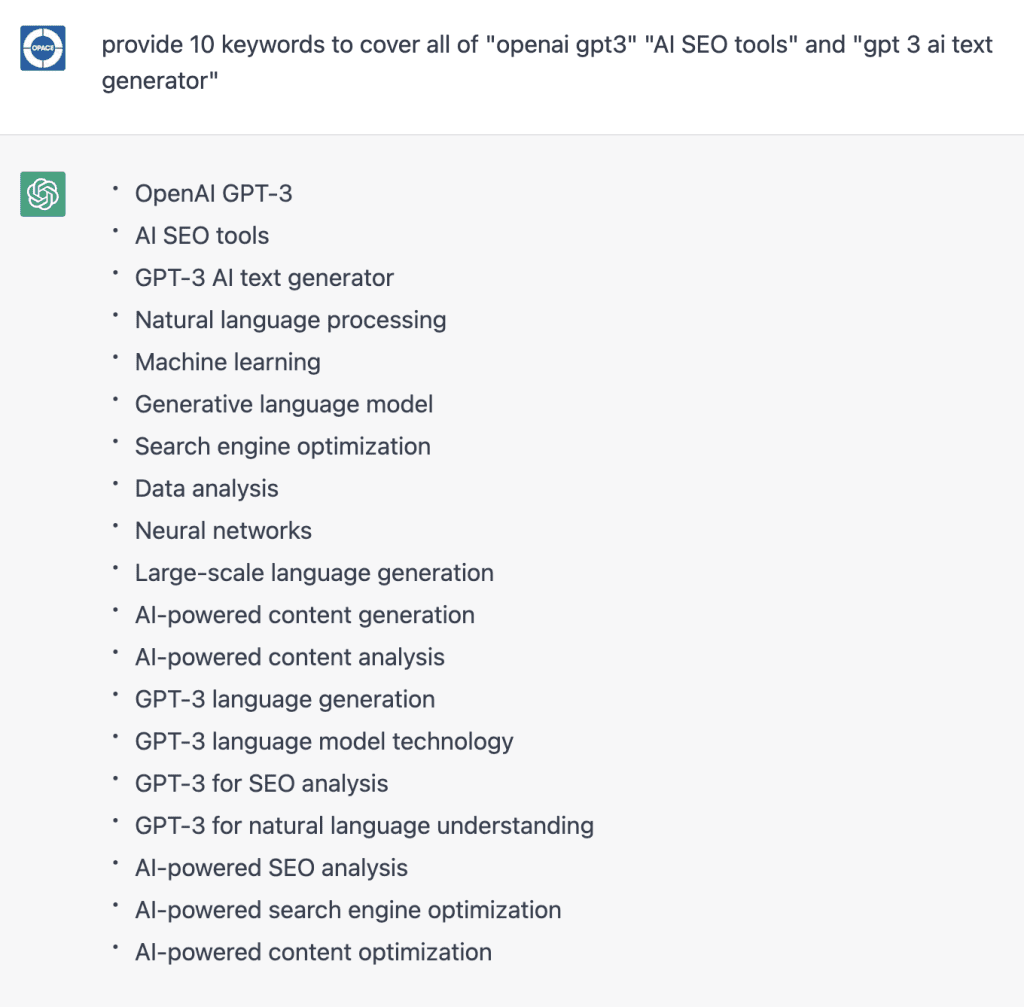
AI keyword research using ChatGPT to give us more ideas
Evaluating search volumes for new keywords
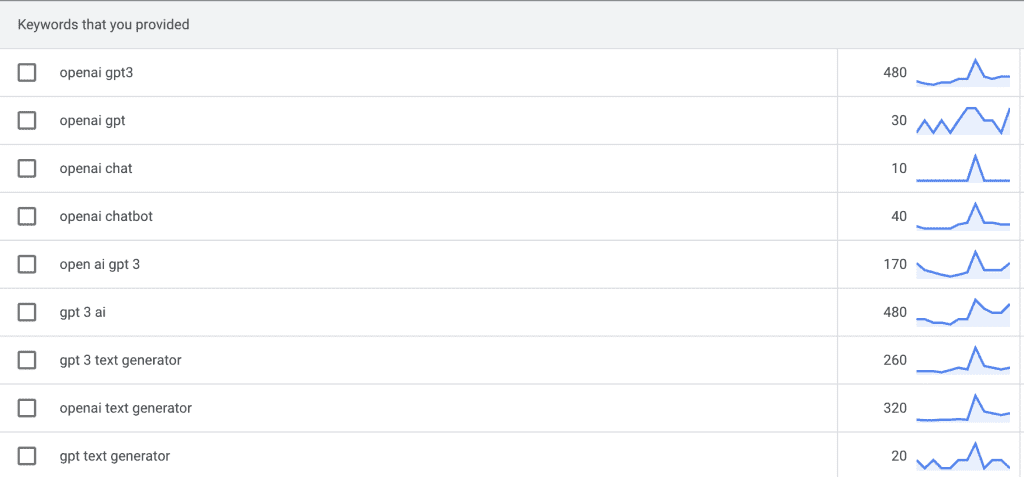
Using the keywords from ChatGPT, check the search volumes
As every SEO person knows, the keyword planning stage is incredibly important. We decided to use the below keywords as a basis for both articles:
- “gpt 3 ai”
- “gpt 3 text generator”
- “openai gpt3”
- “openai chat”
- “ai SEO tools”
Step 2 – Let the AI brainstorm potential titles for the content
The next step was to ask ChatGPT to brainstorm catchy article titles using the keywords above.
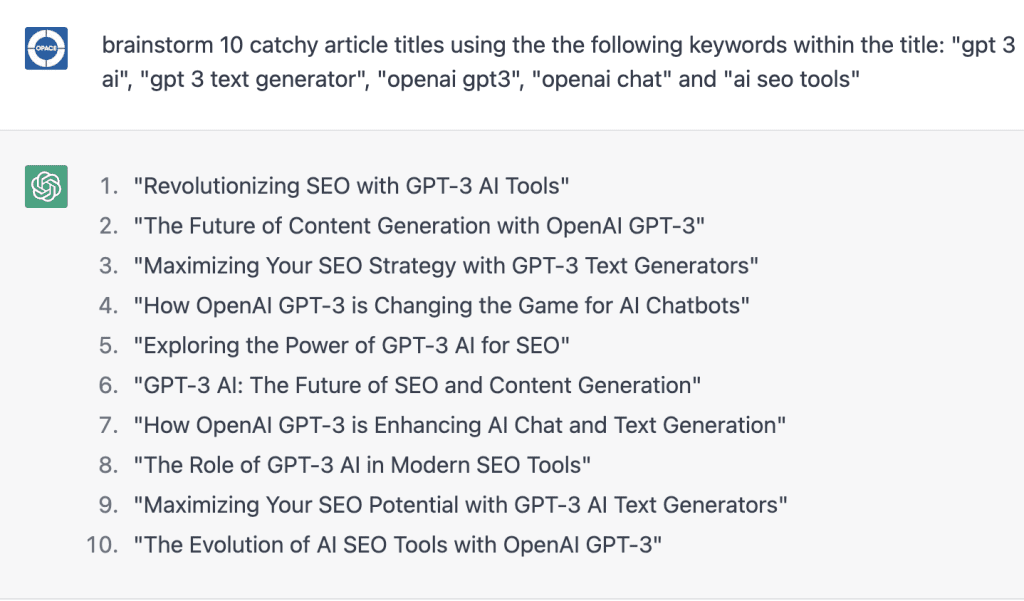
ChatGPT, please brainstorm catchy article titles using the keywords
These were really good, but we thought it would be interesting to test the tool more and ask it to revise the titles to use the keywords exactly,
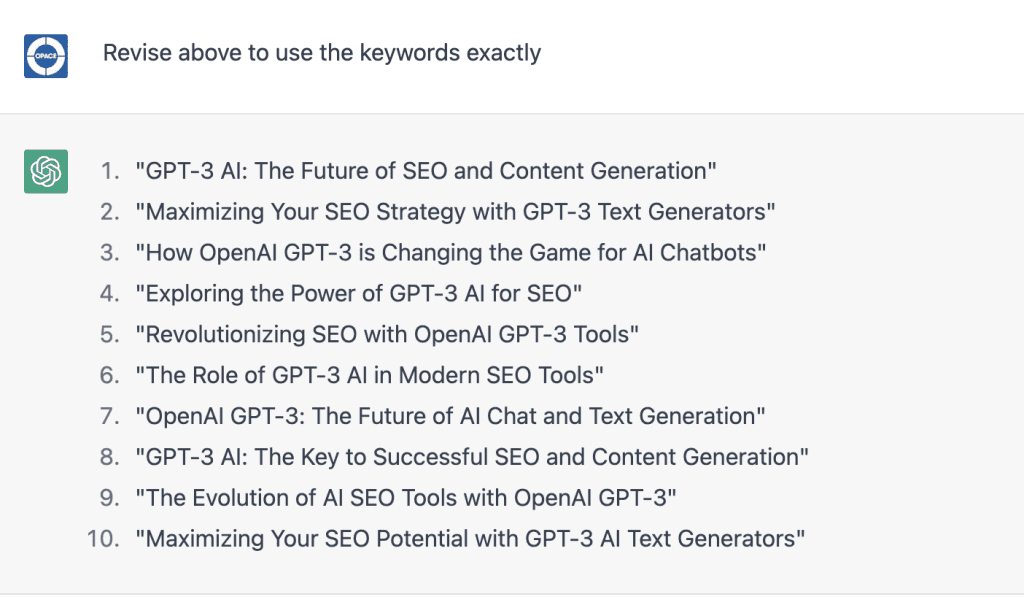
Get AI to refine the titles for the exact usage of the keywords
These titles seemed better, but we wanted to push the capabilities of ChatGPT SEO by asking for more focus on a particular keyword.
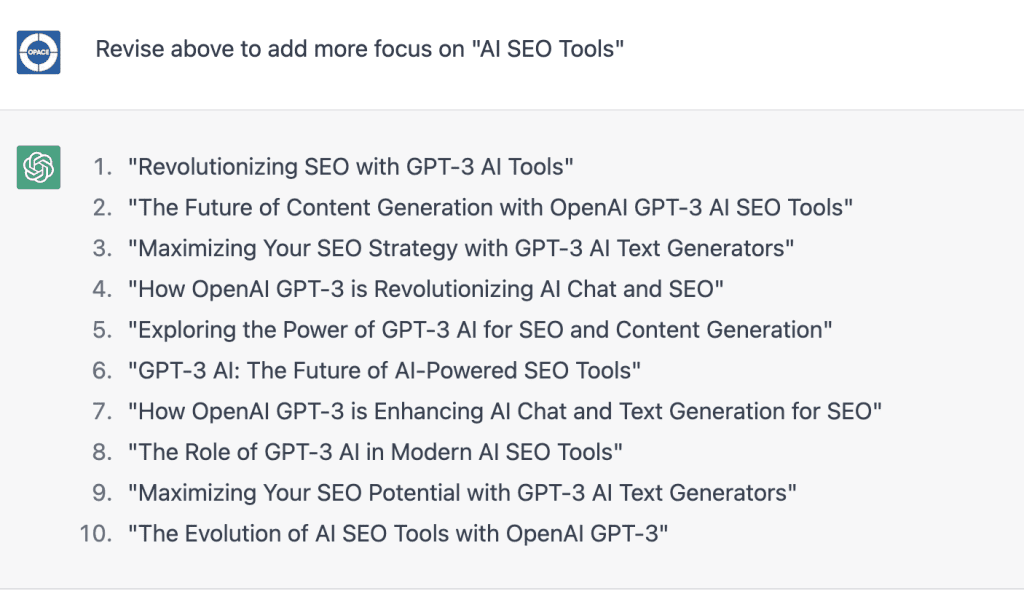
Revise the titles for better SEO
There were some subtle differences as a result of each question, but they largely seemed unchanged.
We’ve been using ChatGPT a great deal more since this experiment and have learnt that there is only so far you can push the tool when it comes to keywords. This seems to be due to its ability to infer meaning and correlate keywords to be one and the same thing.
That in itself has been an eye-opening experience, seeing first-hand how clever this AI is (and most likely, therefore, how clever Google is).
Step 3 – Use ChatGPT to create an outline/structure for the content, including headings
Choosing a tile was tough, but we decided on ‘How OpenAI GPT-3 is Enhancing AI Chat and Text Generation for SEO’ for experiment 1 and ‘The Evolution of AI SEO Tools with OpenAI GPT-3’ for experiment 2.
We asked ChatGPT to create headings for a 1000-word article using the keywords, each in its own heading.
The first list seemed a bit limited, so we asked ChatGPT to revise it to include 10 headings with more detail about what the first and second sections should be.
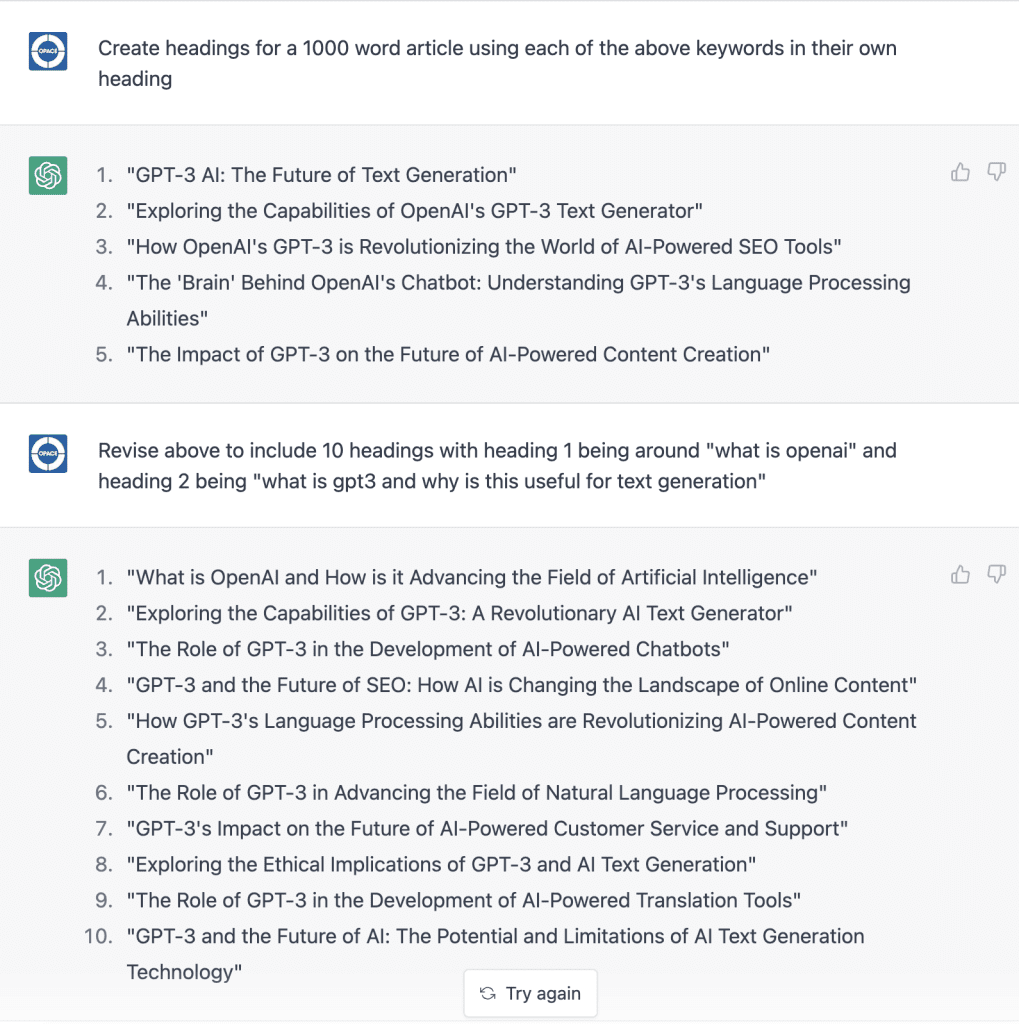
Create headings for a 1000-word article using the keywords in the headings
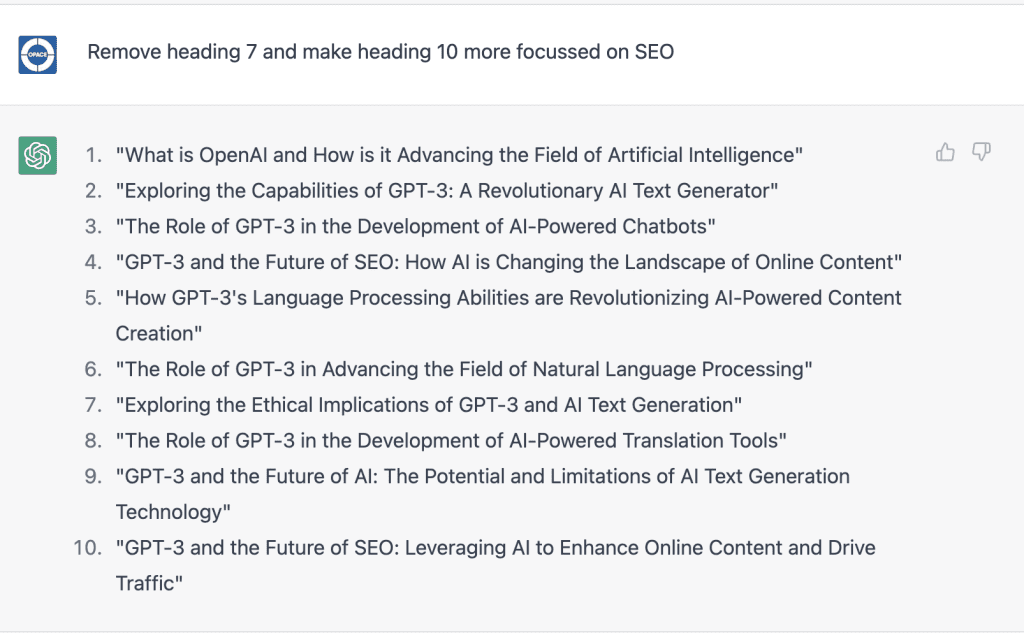
Refine the AI article structure to improve relevancy by removing text around customer service and support, but also conclude with a more SEO-focused heading
Step 4 – Create the all-important intro
Knowing how important the introduction is, we spent some time asking ChatGPT to produce this around the given keywords. We hadn’t really picked out a primary (or focus) keyword, so at this stage, we asked the AI to revise to place more focus on “AI SEO Tools”.
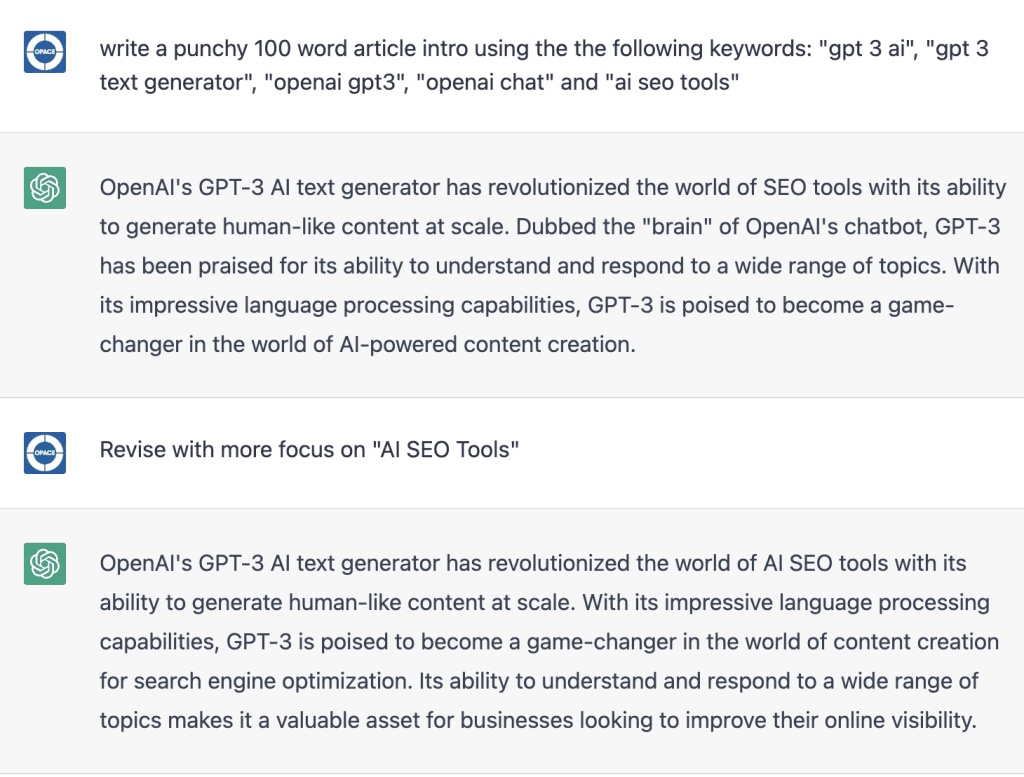
We asked ChatGPT to produce this around the given keywords
Step 5 – Create a table of contents
Even though we have a plugin to insert a table of contents automatically, we asked ChatGPT to produce a TOC so we could see what it came up with.
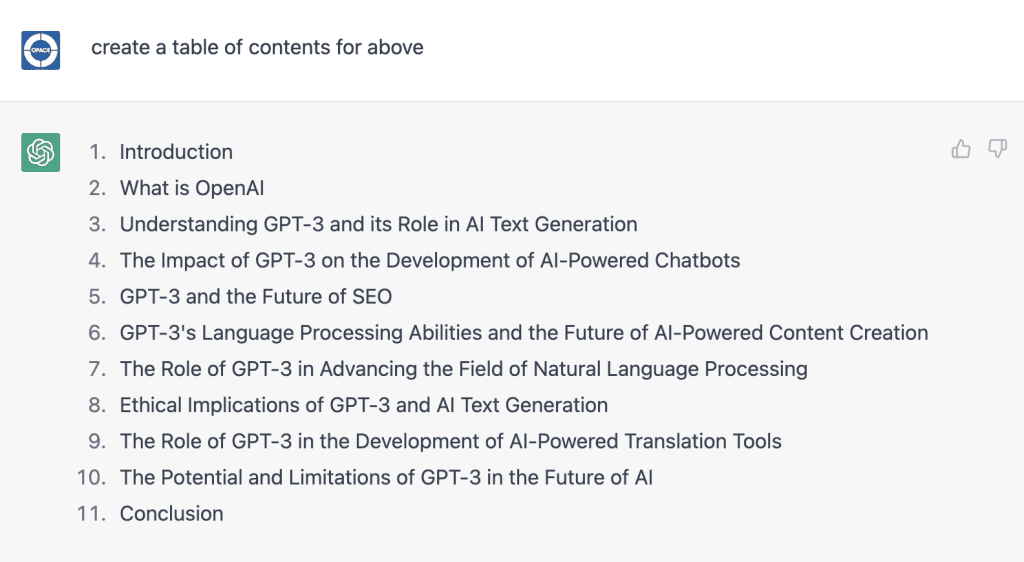
We asked the AI to produce a table of contents
Step 6 – Create and revise the content for each heading
Next was what we had been waiting for. We asked ChatGPT to create between 200 and 400 words for each TOC heading.
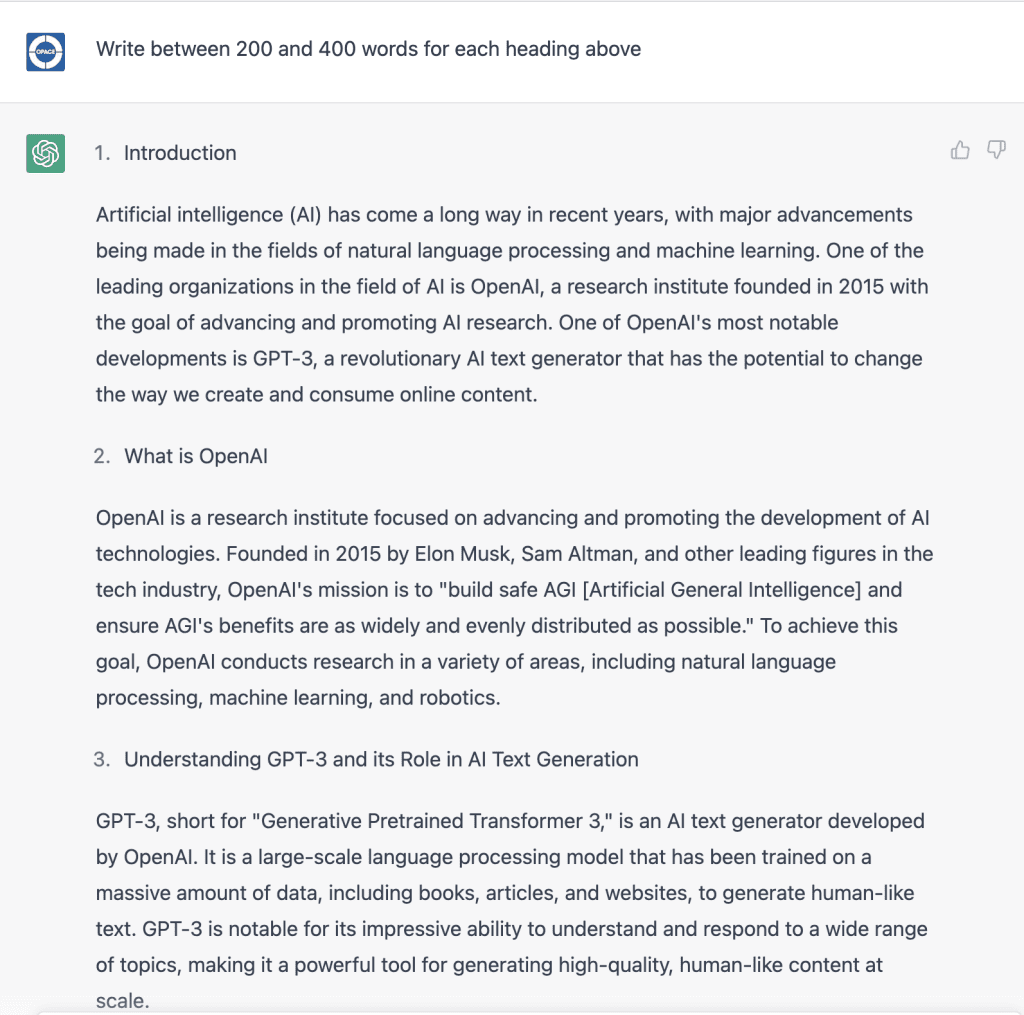
Create between 200 and 400 words for each heading
Side note: Back in 2022, ChatGPT was only able to produce around 400-500 words at a time, so we broke the work into two parts to create the entire article. This is very different today with models like GPT-4.5 4o and o1, each having far greater context windows:
- GPT-4.5: Released on February 27, 2025, this model features a context window of 128,000 tokens.
- GPT-4o: Introduced on May 13, 2024, GPT-4o also supports a context window of 128,000 tokens.
- o1: Launched in December 2024, the o1 model offers an expanded context window of 200,000 tokens.
At the time of undertaking this experiment, the context window for GPT-3.5 was 4,096 tokens, which helps to put things into perspective.
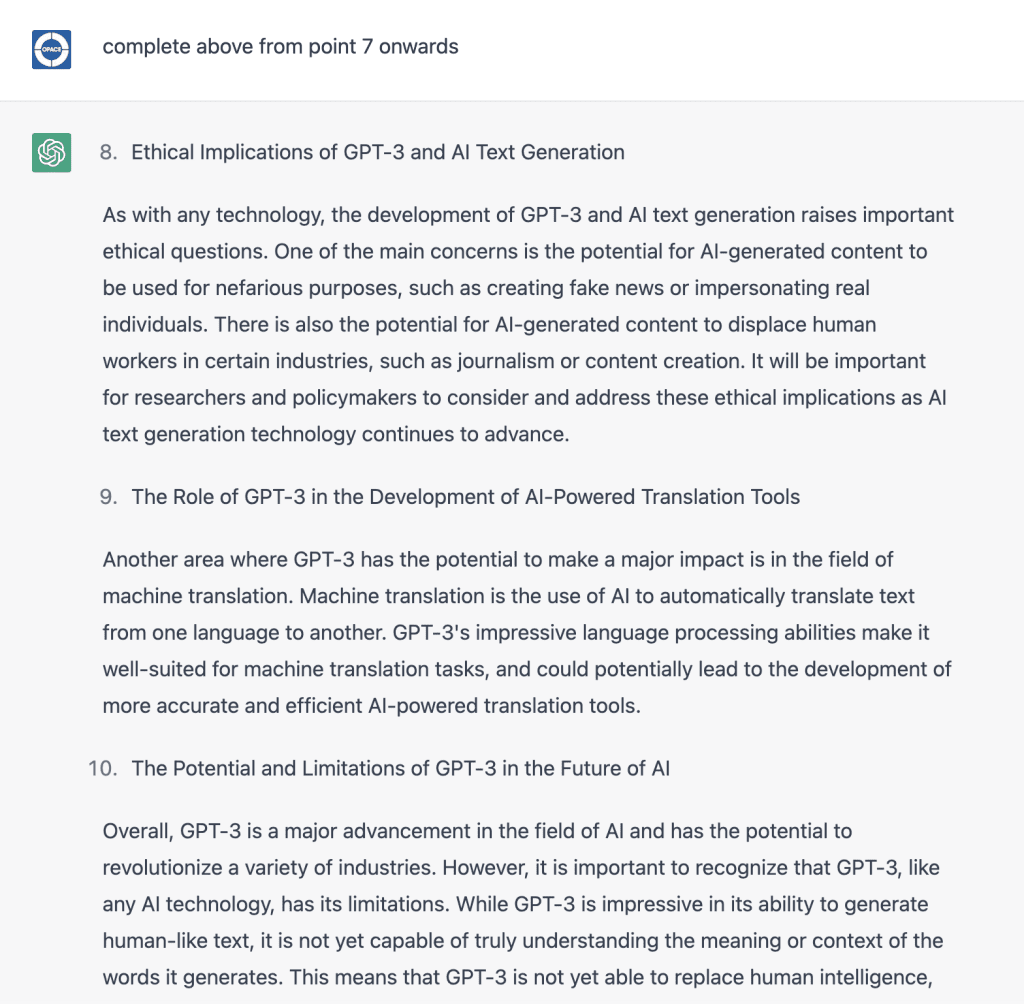
Continue with the remaining headings
At this stage, we felt that the original headings were better and wanted to drop the TOC-style headings
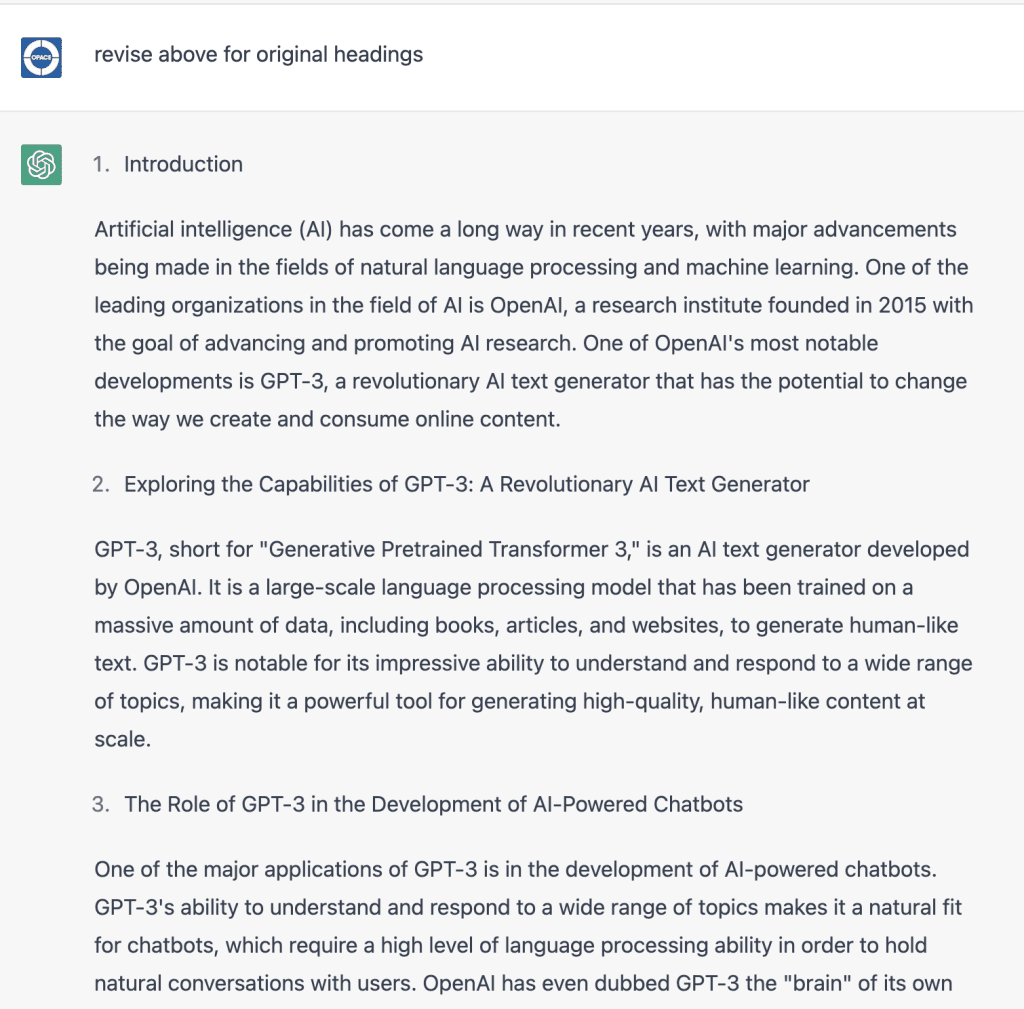
Refine, refine, refine – ChatGPT revised the headings back to the original ones
Still unhappy with how the article looked, we asked the AI to re-write the intro to make it more catchy and include data.
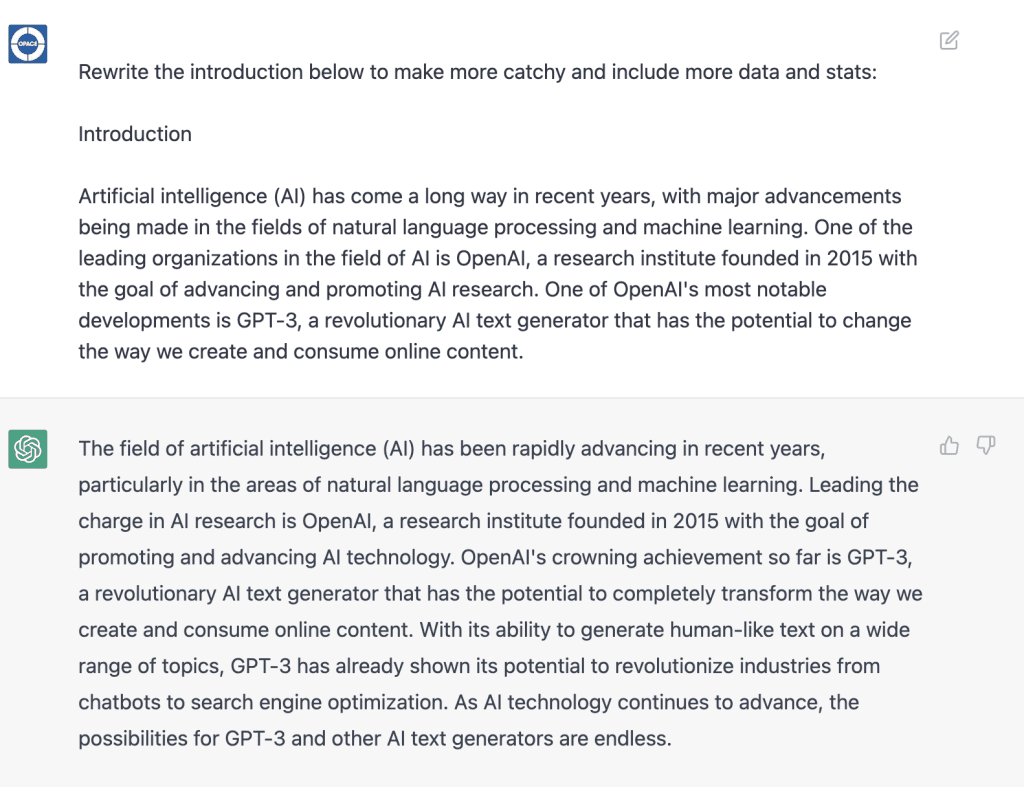
Re-write the intro to grab the reader’s interest
We felt the conclusion was missing something, so we asked ChatGPT to produce a snappy call to action for the conclusion.
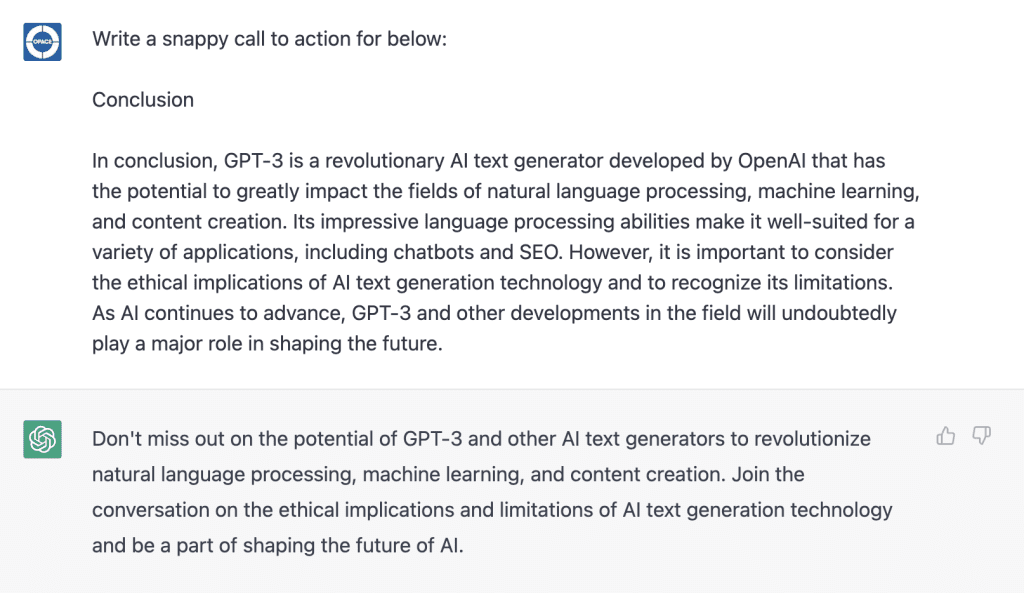
ChatGPT, please finish the article with a snappy call to action
We really weren’t sure what to expect with these tests, but first, we wanted to get ChatGPT to recommend a Google-friendly URL.

Recommend a Google-friendly URL
Given the tool only seemed able to work with around 400-500 words at a time, we thought we would try another interesting experiment. At this stage, we uploaded everything to our WordPress blog and published the article in basic text format.
We then asked the AI to read the URL and provide the HTML code.
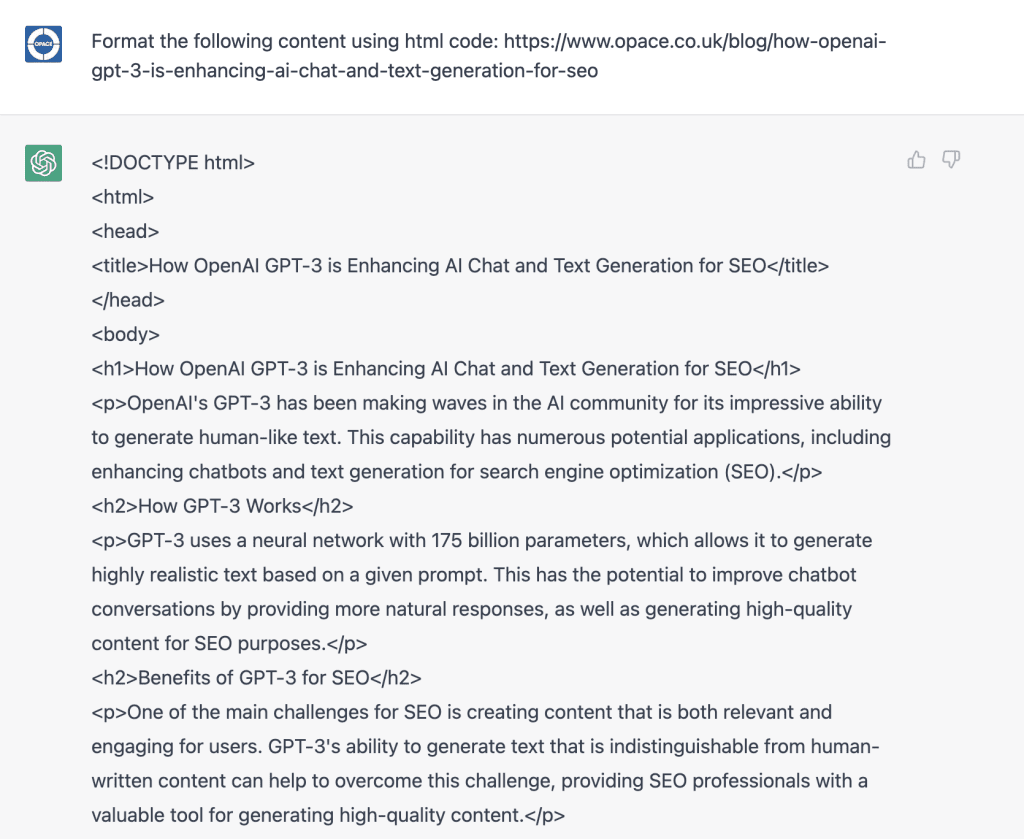
Provide the HTML code based on our URL
Side note: In hindsight, we think that ChatGPT probably just remembered the previous text and provided the HTML output based on this. We now know that ChatGPT couldn’t browse URLs or the web back in 2022. Even when asked, ChatGPT clearly stated that it could not get information from a specific URL.
![Can chatgpt get into from a website or url - using chatgpt for seo: "mind blowing" chatgpt seo guide & case study [updated] Can chatgpt get into from a website or url](https://opace.agency/wp-content/uploads/2022/12/Can-ChatGPT-get-into-from-a-website-or-URL-1024x206.png)
Can ChatGPT get info from a website or URL?
To see what else was possible, we used carefully worded ChatGPT SEO prompts to create the meta tags. We’re only touching the surface of what’s possible here.
To get a greater understanding, see our ChatGPT meta data guide below.
This is what it came up with:
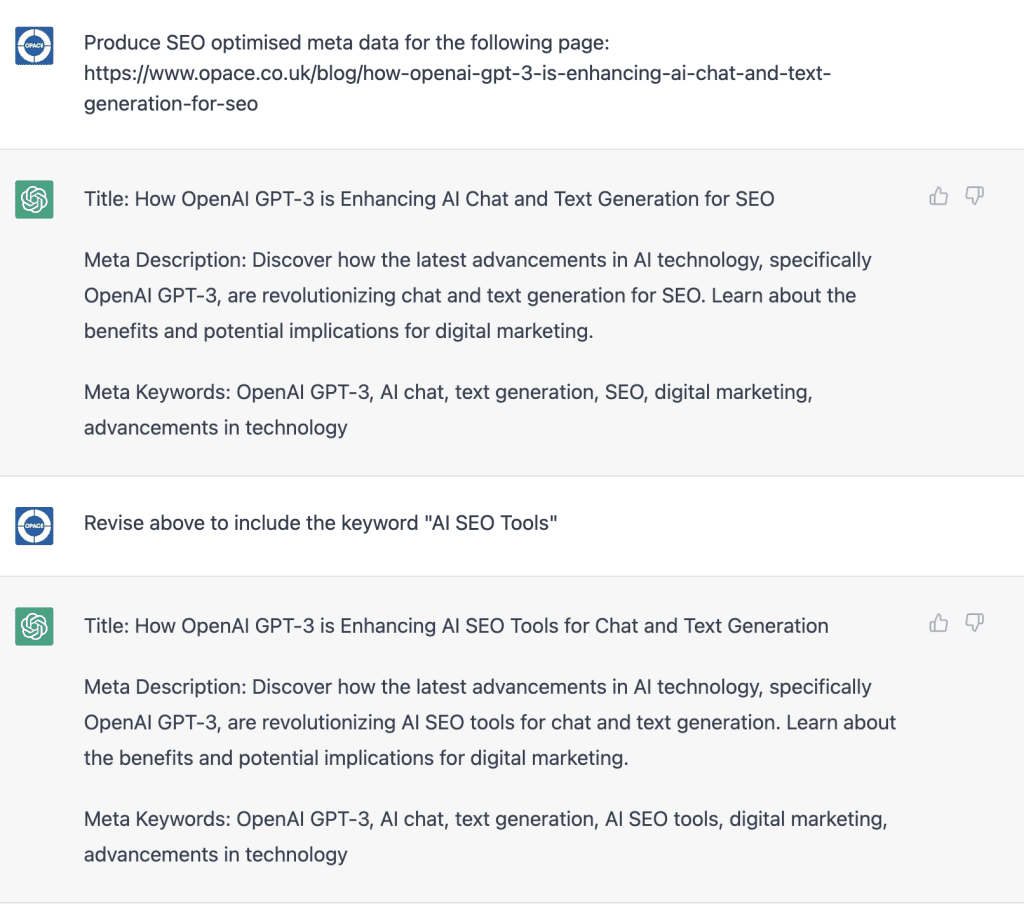
Meta data created using ChatGPT SEO prompts
At this stage, we made a very strange decision and decided to change the primary keyword for something more generic ‘OpenAI GPT-3’.
This was probably a mistake, but we also wanted the AI-generated article to score well with the Rank Math SEO plugin for WordPress. After all, nobody likes seeing red or amber traffic lights when it comes to SEO.
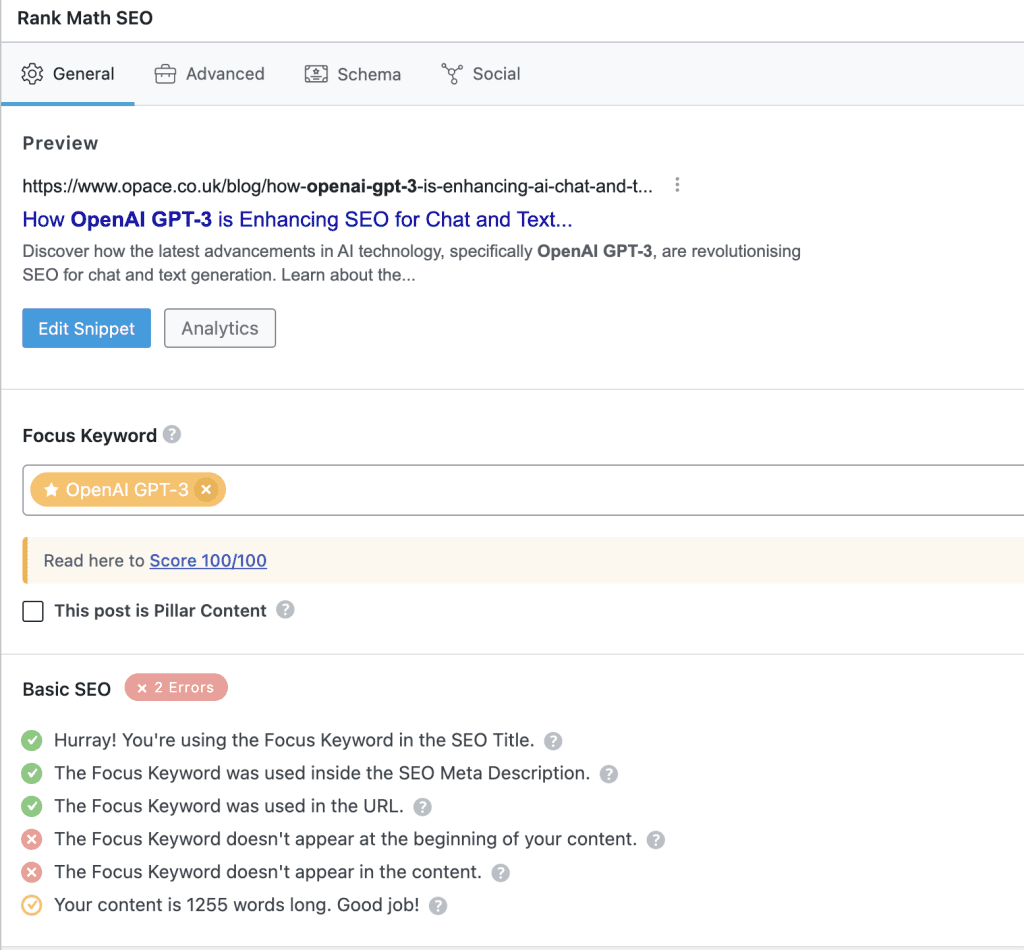
Change direction based on RankMath suggestions
Then, we asked the AI to add hyperlinks from five different websites. This was quite disappointing, but in hindsight, we should have guessed this wouldn’t be possible.
Initially, we were excited when we saw what appeared to be relevant hyperlinks being added.
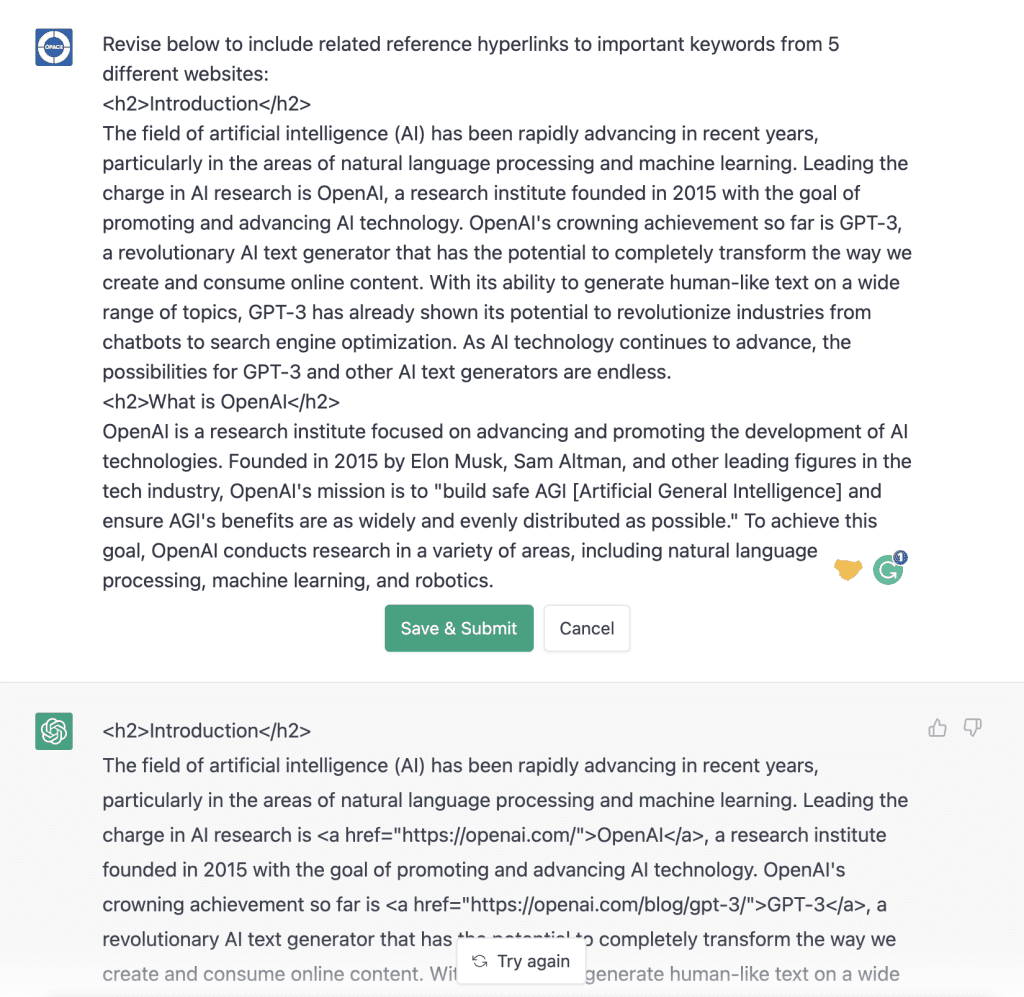
We were excited to see AI-generated hyperlinks being added
Side note: We learnt afterwards that ChatGPT was hallucinating and coming up with fictitious URLs that seemed relevant to the domains added. Strangely, some of the URLs actually worked, which was most likely a fluke, but more on this later.
Step 8 – Add formatting including bold, bullet listed, hyperlinks and revise keyword usage
The next logical step was to add some formatting, so we asked the AI to highlight keywords in bold.
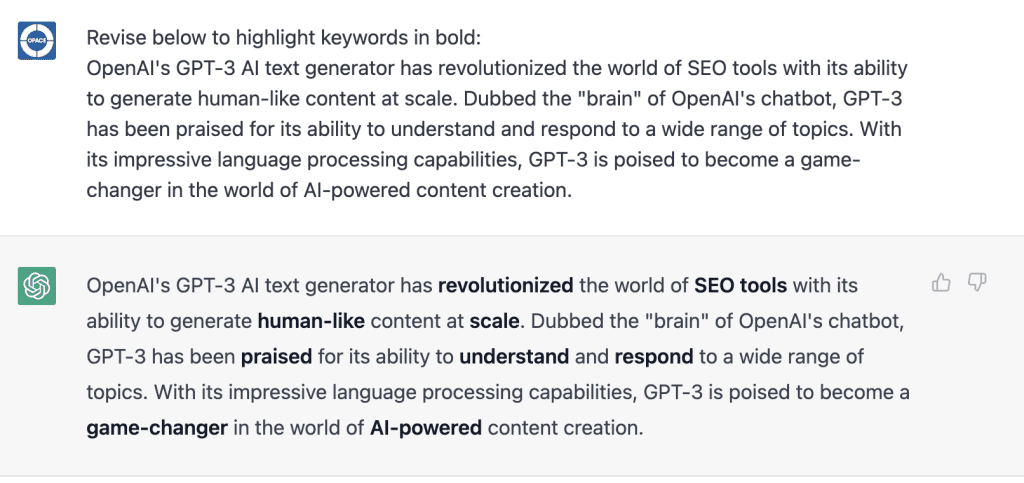
Highlight keywords in bold, please ChatGPT
For a fairly radical overhaul, we asked ChatGPT to revise the entire article for the new primary keyword ‘OpenAI GPT-3″.
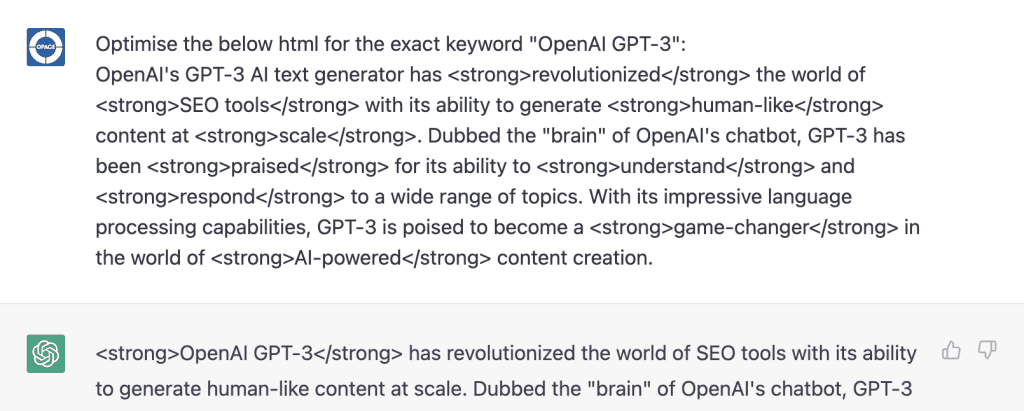
Revise the entire article for the new keyword ‘OpenAI GPT-3″
Then, we went back to Rank Math to get some validation by seeing those all-important green traffic lights. Yes, we know – this was a mistake, and we shouldn’t have changed the article at this stage just for some green, shiny traffic lights. That said, the experiment was still intact – all of the content was still AI-driven, and our only input was regarding keywords.
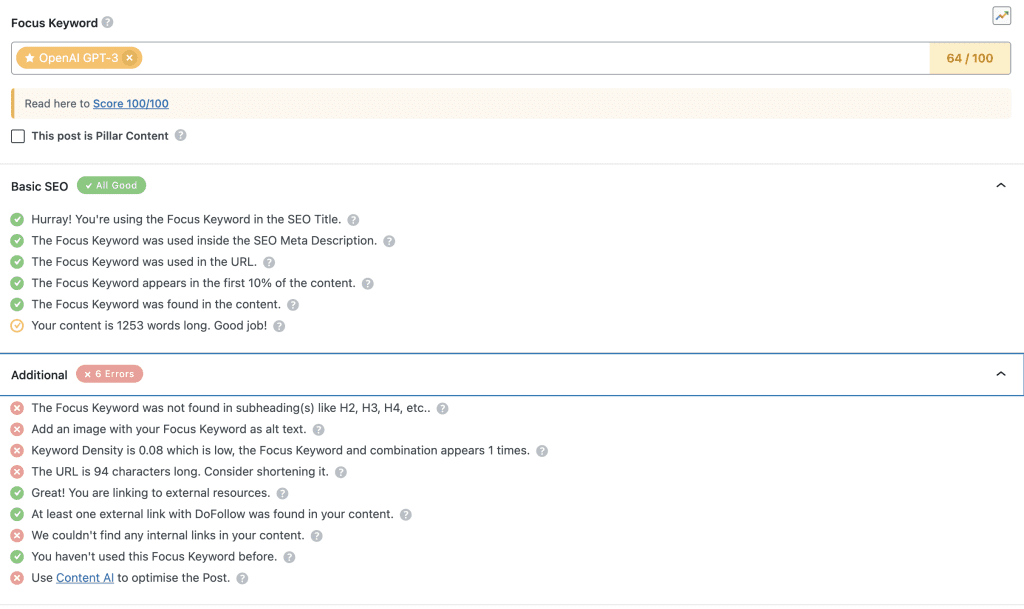
Rank Math, we need some green traffic lights
A few more tweaks were needed to the headings based on the keyword change.
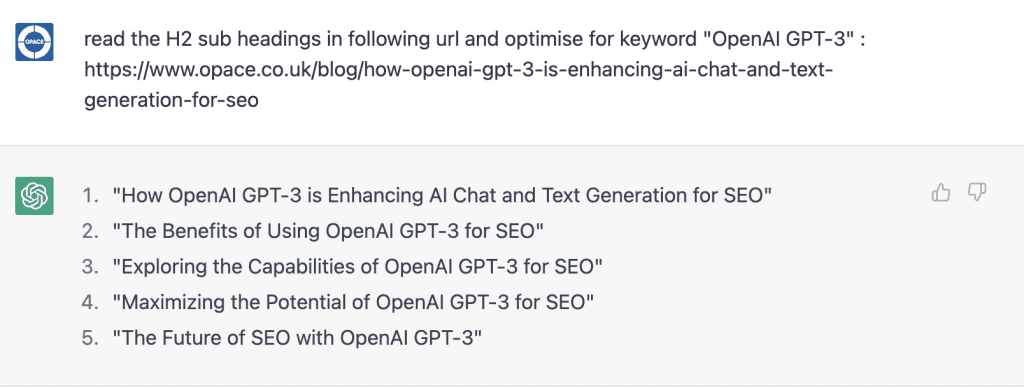
More keyword changes needed, please
The SEO suggestions made by Rank Math are often useful, but we don’t always agree with them. We thought we would put ChatGPT to the test again and ask it to make its own SEO suggestions to improve the keyword density.
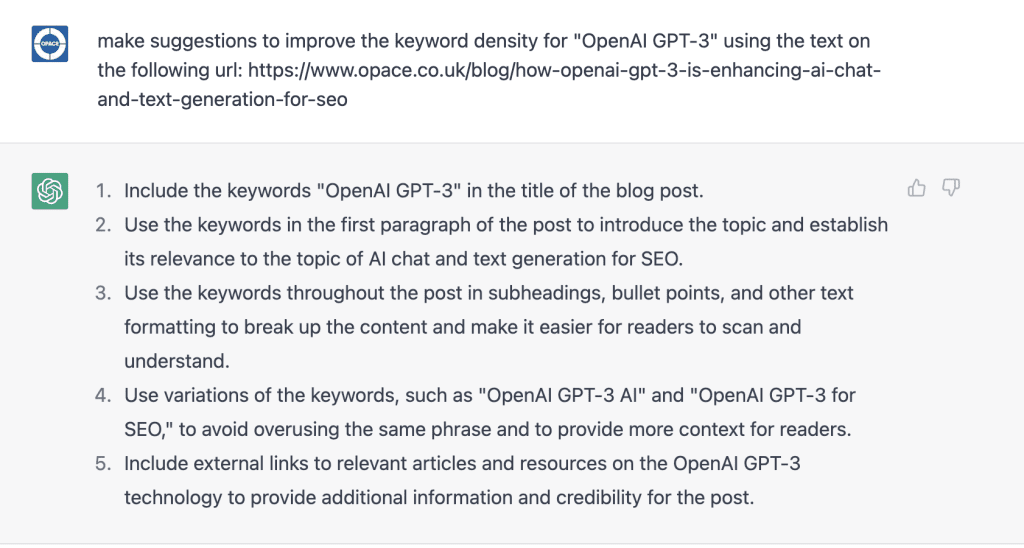
We asked ChatGPT to make suggestions to improve the keyword density
We thought it would be nice to add some reference sites at the end of the article for further reading, so we asked the AI for suggestions.
Remember that important note we added previously about hyperlinks being fictitious? Here’s the proof – these are all made up by ChatGPT.
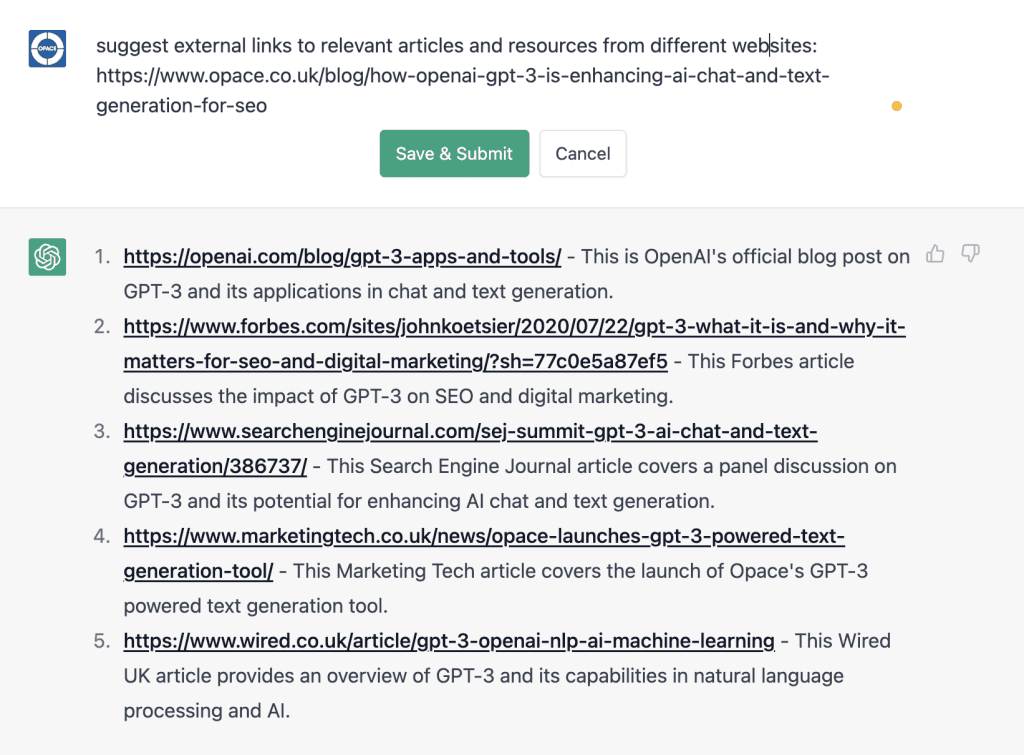
Suggest relevant articles and resources – they were all made up!
It became immediately obvious when we saw our own brand “Opace” mentioned on marketingtech.co.uk (apparently, we’ve launched our own AI text generator, but we knew we hadn’t).
We asked for some additional sites, and again, some of these actually worked, which was most likely a fluke.
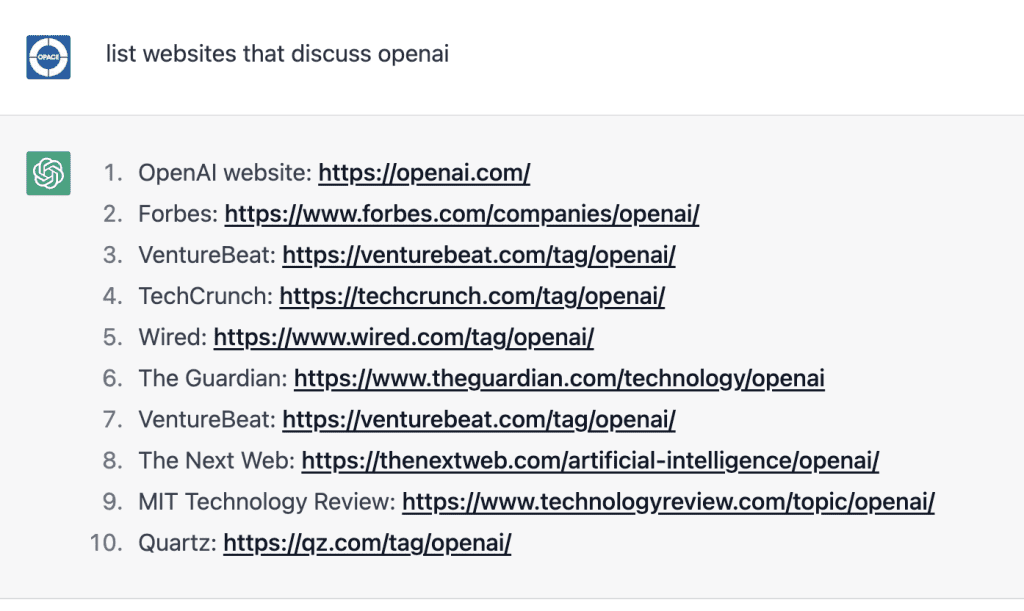
List websites that discuss OpenAI
A bit more formatting was needed as we’re big fans of bullet lists.
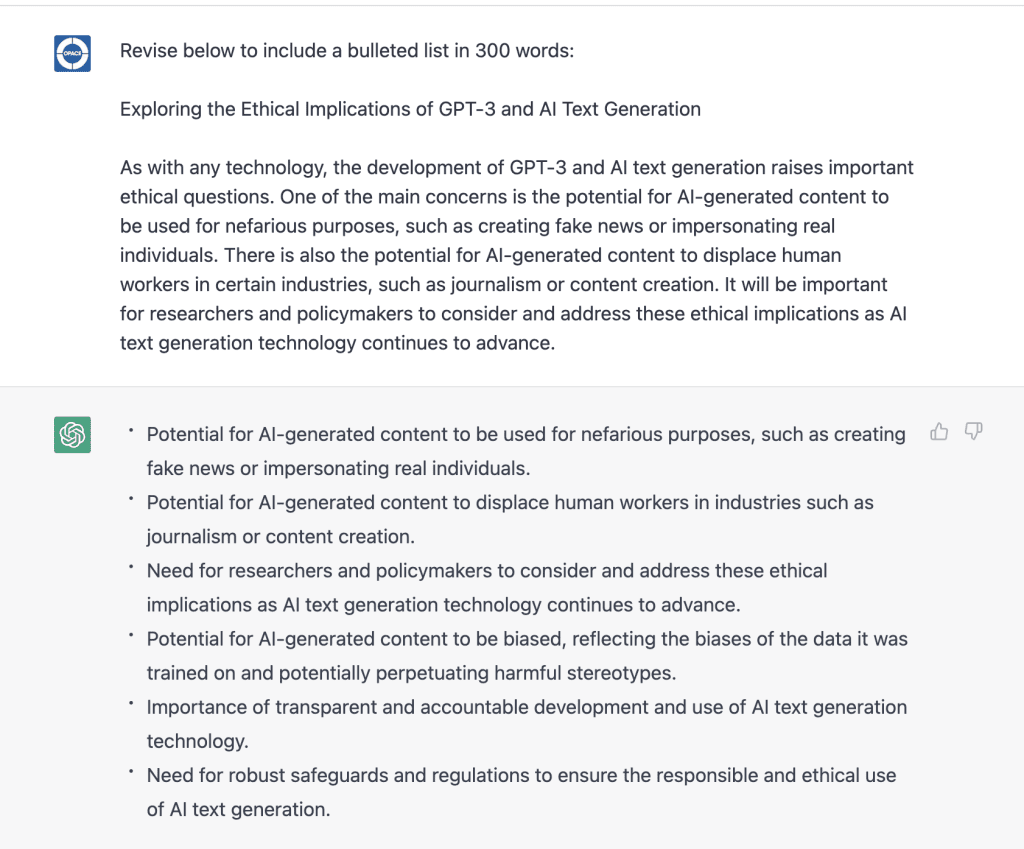
Revise the text to include a bullet list
If that wasn’t enough, we were keen to add a new supplementary section on SEO. We already had ‘What is OpenAI’, so we felt that ‘What is SEO’ was also needed.
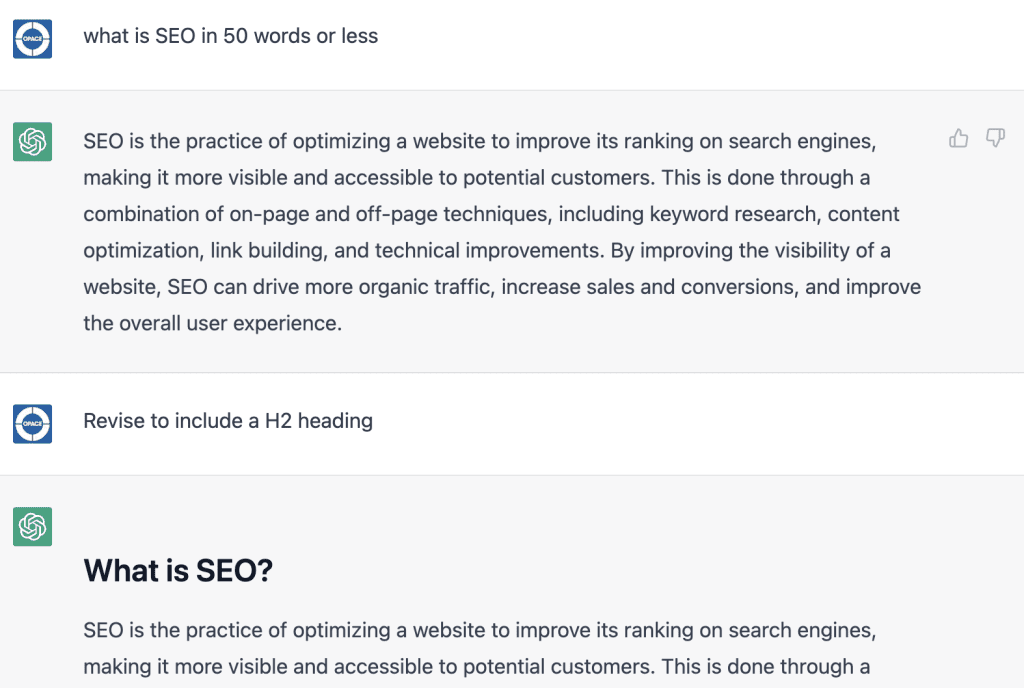
Write a new supplementary section on SEO and include a heading
Nearing the end of our experiment, we asked Chat GPT to revise the conclusion based on a specific keyword density. This worked, but it didn’t quite achieve 3%.

Revise the conclusion for a keyword density
Finally, we asked ChatGPT to suggest a list of tags that we could input into WordPress.

Produce a list of AI-generated tags
Step 9 – Create a featured image using AI (DALL-E)
Given that everything else was AI-generated, we weren’t going to resort to finding stock images. This is what we got.
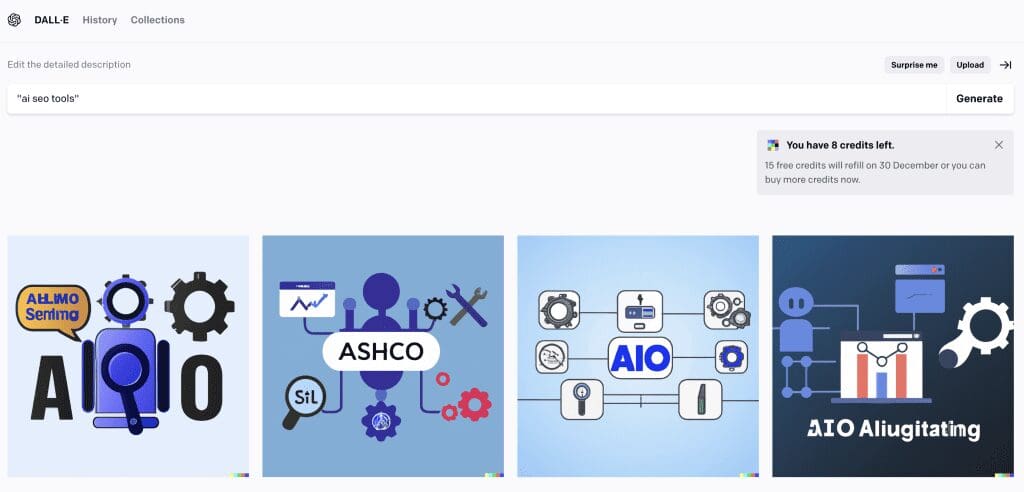
We got an AI-generated featured image using DALL-E
Side note: Notice the strange text and words contained within the images? Another significant change between 2022 and 2025 is the evolution of Dall-E and other generative AI models. We currently have models like Dall-E 3, Stable Diffusion 3, Google Imagen 3, and Ideogram 2, all of which are better (but not perfect) at including text.
We thought it would be interesting to get ChatGPT to come up with the image prompt to put into DALL-E for a second image, so we asked ChatGPT to suggest a good descriptive sentence to get DALL-E to produce an image about the ethics of using AI in an abstract format.

ChatGPT, please come up with the text to put into DALL-E
This was what we got – it’s all personal preference, but these seemed far more interesting than the original images.
![Dall e more interesting ai image generation - using chatgpt for seo: "mind blowing" chatgpt seo guide & case study [updated] Dall e more interesting ai image generation - using chatgpt for seo: "mind blowing" chatgpt seo guide & case study [updated]](https://opace.agency/wp-content/uploads/2022/12/dall-e-more-interesting-ai-image-generation-1024x490.png)
Step 10 – Let ChatGPT create an article in full
This one will be kept short.
We decided on the title ‘The Evolution of AI SEO Tools with OpenAI GPT-3’ as this felt like a much better match for the keyword ‘AI SEO Tools’.
We let the AI generate the article structure and headings and then continue to produce the entire article. Once this was produced, we requested meta tags and created a featured image using DALL-E. The whole process took a minute or so to complete, and the resulting article is below.
The findings – Our test results revealed
Remember the initial theories? We’ve summarised these below:
- The content would be largely duplicated based on experience with other AI content generators
- The content wouldn’t be favoured by Google
Does the content suffer from duplication? – No
The first article passed Copyscape with flying colours.
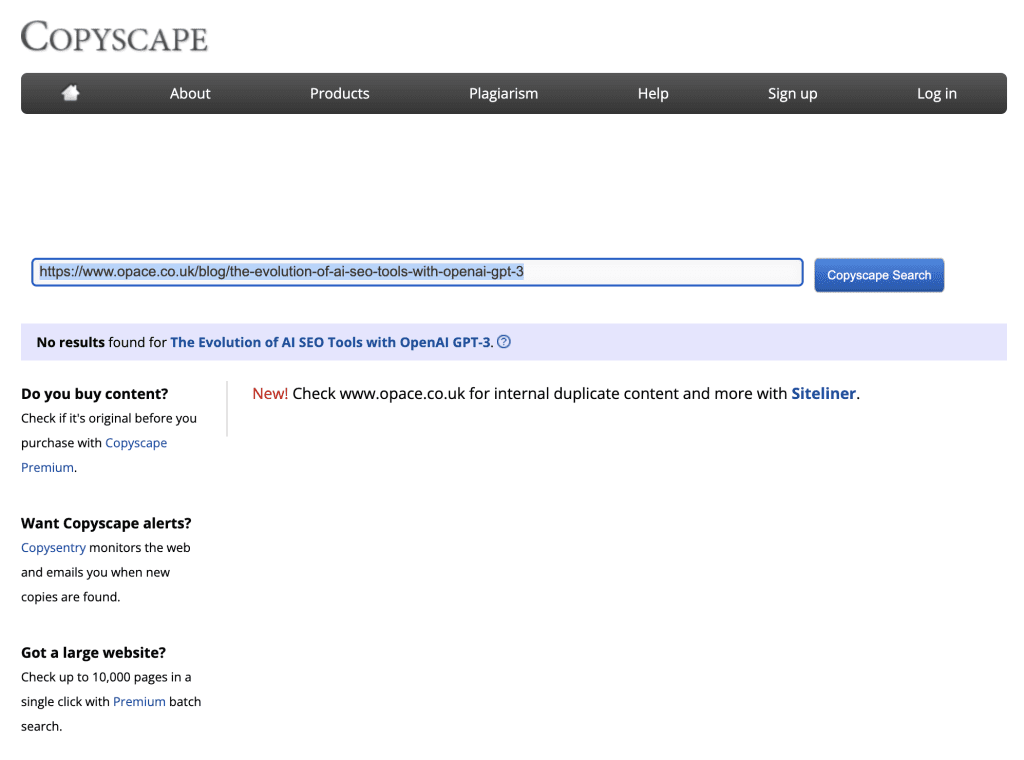
The second article had a very small amount of duplicate content resulting from a quote included.

Experiment 2 suffered from minor duplication
We felt we could live with this. In the spirit of staying true to the experiment and the next test, we didn’t want to make any changes.
Does the content rank well in Google? – yes
This one was probably the biggest surprise for us. Both articles were indexed overnight and ranking in Google the very next day.
Initial tests actually showed both articles ranking for some of the same keywords – and on page 1.
The first one we noticed was “OpenAI SEO”. It seems like a good search term, given that this is what we are trying to test.
Seeing our AI-generated content ranking right next to a detailed article from Search Engine Journal was nice. Sadly, the keyword isn’t showing as having any search volume according to Google Keyword Planner. As most of us know in the SEO industry, there’s no point in being number 1 if nobody is looking.
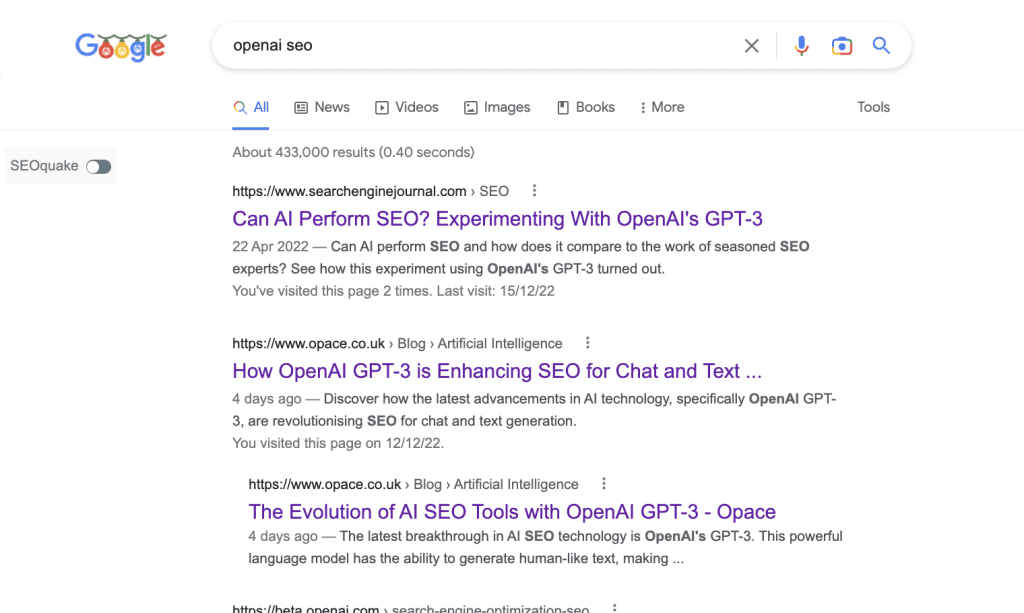
Are we ranking for OpanAI SEO?
Once the articles had been live for a few days, we could get clearer results. The keywords “GPT-3 for SEO”, “GPT-3 SEO”, and similar keyword searches ranked position 5 on Google. That was an impressive result but still a relatively small search volume.
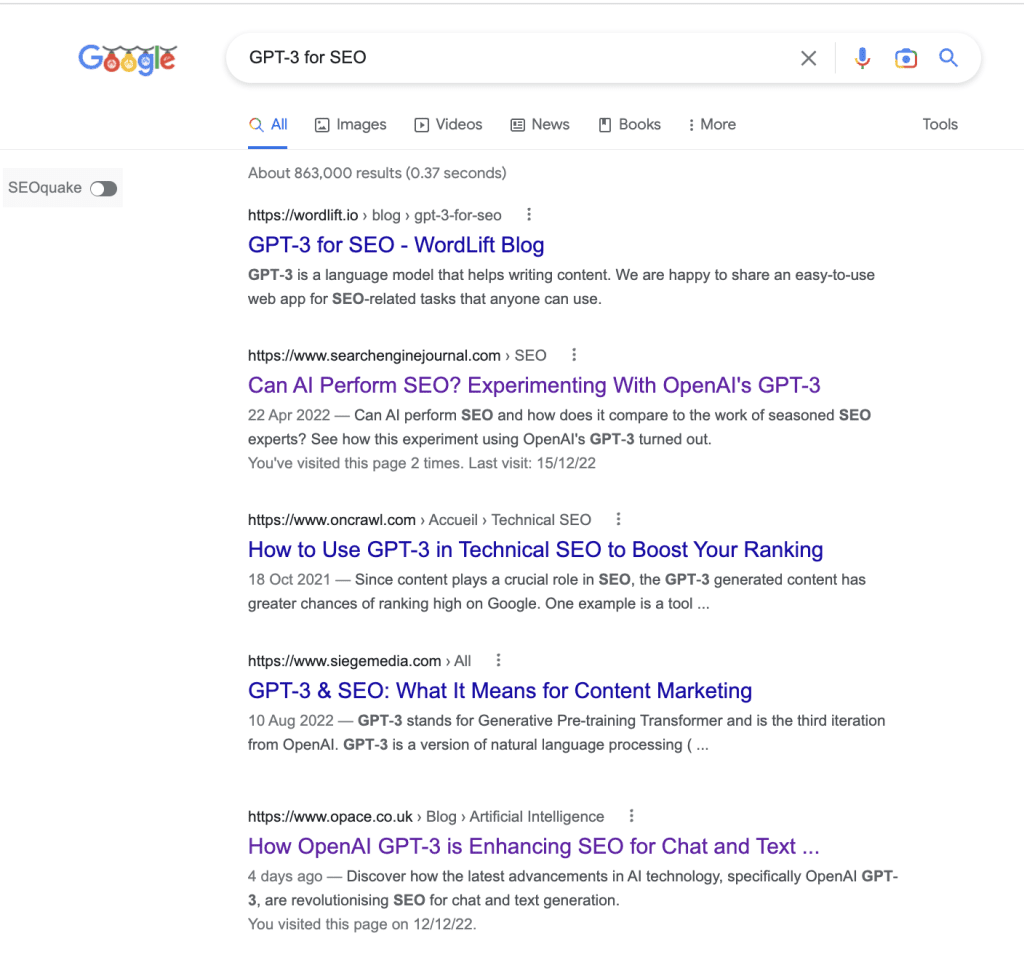
Are we ranking for GPT-3 SEO?
Sadly, we were not ranking on Page 1 for the primary keyword “OpenAI GPT-3”, but we weren’t not far off, ranking at position 14 when we last checked.
For the complete list of ranking keywords, see below:
![Ai keyword rankings - using chatgpt for seo: "mind blowing" chatgpt seo guide & case study [updated] Ai keyword rankings - using chatgpt for seo: "mind blowing" chatgpt seo guide & case study [updated]](https://opace.agency/wp-content/uploads/2022/12/AI-keyword-rankings-1024x482.png)
This seemed astonishing.
Within only 4 days, our ChatGPT created articles were both showing promising rankings for good keywords.
We were only 5 positions away from Page 1 for “OpenAI GPT-3” with 370 UK monthly searches. Crikey, we were even ranking in position 24 for “GPT-3” with over 10K monthly UK searches. We never expected to be ranking at all for a keyword like this with 100% generated AI content.
Do the articles generate real traffic? – Yes
Since publishing the two experiments, only a handful of days later, they were generating more traffic to our website than any other content within the same period of time.
What’s more, we hadn’t shared the content at all (no social media). We hadn’t linked to the content, and we’ve hadn’t even changed the US spellings to UK British to avoid modifying the content in any way.
Even more than that, look at the average time people spent reading the first article; it’s a whopping 10 minutes or more.
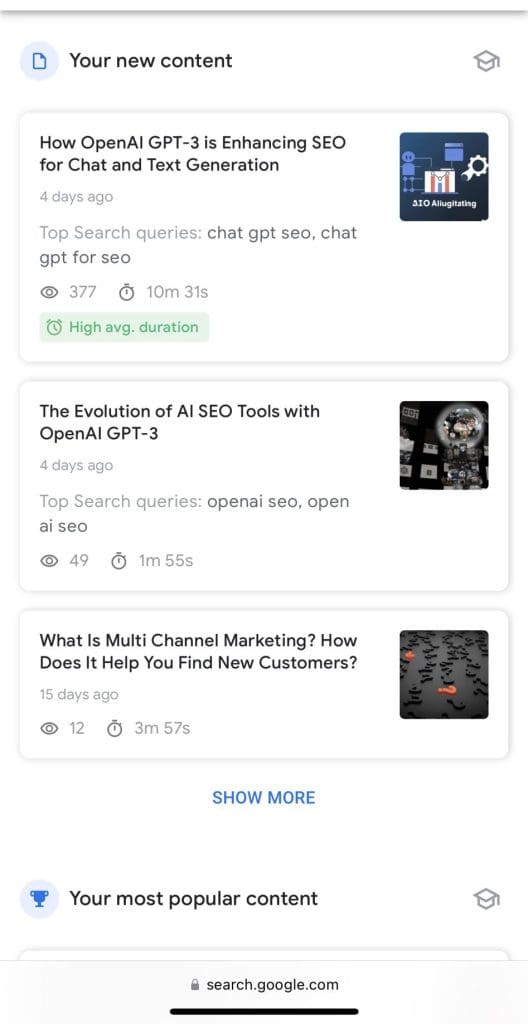
Will people read and engage with the content? – Yes
The above image alone shows that the content is sticky enough for people to spend 10 minutes or more on the page.
The second “AI SEO Tools” article doesn’t perform as well, but it was still number 2 on our list according to Google Search Console.
Could AI replace content creation and SEO altogether? – Maybe
In our opinion at the time, this was a potentially “yes” – but only in terms of the writing.
Probably the most important (and time-consuming) part of creating the first article was coming up with the right keywords, title and structure for the article.
Google Keyword Planner played a role in this, and we felt search volume would always need to play a role in deciding keywords. AI-generated ideas alone weren’t enough.
Human decisions were made throughout Article 1 to tailor the content and enhance/improve what was being said.
Article 2, which had next to zero human input, was ok. It ranked in Google, but not as well.
Our main concern with Article 2, and potentially both articles, was the actual data and facts included. Article 2 made some questionable decisions when claiming things like “One of the leading examples of this type of AI SEO tool is Articoolo”. There were far better tools to cite, but we didn’t want to interfere with the process.
This alone shows that human proofreading and data checking would be needed for the foreseeable future.
Is AI a useful assistant or a hindrance to SEO? – The answer is “assistant”
At best, ChatGPT was close to replacing content writers, and at worst, it was an incredible assistant.
If we deemed it was useful, would it save time, improve quality, etc.? – Yes
This one is interesting.
The first article took so much time to produce that one of our copywriters could have produced their own article in a similar amount of time. However, this was largely due to experimentation with ChatGPT and trying to find the right questions. It was clear that AI tools like ChatGPT could make huge time savings, especially in terms of researching the topic.
With some refinement, we felt the process could be reduced to a matter of minutes. In fact, since publishing the two articles, we have come up with a range of prompts, processes, and guidelines to help enhance the quality of AI-generated content.
As can be seen below, we’ve used this to get ChatGPT to evaluate its content. An old version of these promots can be seen below, along with the answers for the first article:
![Get the ai to evaluate its own content - using chatgpt for seo: "mind blowing" chatgpt seo guide & case study [updated] Get the ai to evaluate its own content](https://opace.agency/wp-content/uploads/2022/12/get-the-AI-to-evaluate-its-own-content-1024x662.png)
Get ChatGPT to evaluate its own content
It passes for each question other than UK British spellings, which we expected.
Which article wins?
Article 1 is the clear winner!
Does ChatGPT only work with text?
While the purpose of this guide is to cover ChatGPT SEO and its capabilities for written content, we can confirm that ChatGPT covers so much more than just written content.
Even back in 202, ChatGPT had the ability to turn natural language into code. ChatGPT was shockingly good at evaluating code, identifying bugs, commenting on code, optimising code, and even writing complete applications in various programming languages.
If that wasn’t impressive enough, we also managed to get ChatGPT to convert a JavaScript app into plugins/extensions for web browsers, WordPress and Magento.
For examples of other applications, WordPress users can check out a wide range of ChatGPT plugins to experiment with creating different types of content.
10 AI-Powered ChatGPT WordPress Plugins To Enhance Your Marketing
As of March 2025, the capabilities of ChatGPT have changed significantly beyond text-based interactions, far beyond anything we would have imagined in 2022.
- Multimodal inputs and outputs: With the introduction of GPT-4o in May 2024, ChatGPT can now process and generate not only text but also images and audio.
- Advanced reasoning: The o-series models, such as o1 and o3, have enhanced ChatGPT’s ability to perform complex reasoning tasks, including coding, mathematics, and scientific problem-solving.
- Deep research: Launched in February 2025, the Deep Research feature allows ChatGPT to autonomously browse the web and generate comprehensive reports on specified topics within 5 to 30 minutes.
- Operator agents: Introduced as a research preview in January 2025, Operator enables ChatGPT to use its own browser to browse the web and perform tasks like a human operator.
- Custom GPTs: Users can create personalised versions of ChatGPT tailored to specific tasks and their own internal knowledge base.
- Canvas: The Canvas feature provides a workspace where users can interact with ChatGPT in a more visual, collaborative and interactive manner, facilitating tasks like writing and programming.
- Vision: ChatGPT’s ability to interpret and analyse images has been enhanced, allowing it to provide detailed descriptions and insights based on visual inputs.
- Task scheduling: The Tasks feature allows users to set reminders and schedule recurring tasks, with ChatGPT sending push notifications for activities like reading updates or managing daily routines.
The possibilities now for using ChatGPT for SEO, along with a wide range of other digital marketing and business processes, is almost endless.
Can SEO be enhanced with a ChatGPT content refresh? (Jan 2023 update)
A couple of months after our two experiment articles were published, we decided to give our AI SEO tools experiment (Article 2) a refresh, but why?
Firstly, we were never happy with the content provided in this article and some of the tools referenced. Without ruining the experiment and rewriting or editing the article ourselves, we wondered what would happen if we used ChatGPT to enhance the article by using different prompts and queries.
Secondly, we know from experience that updating content and keeping it fresh/up-to-date can provide huge ranking improvements.
Interested to find out what happened? It worked.
We asked ChatGPT to provide a brief history of AI SEO tools. Based on its response and inclusion of IBM Watson Analytics, we revised our original prompts to update the article to include different companies that have been significant in the field of AI SEO.
We were told about a wide selection of players (see below), and they all got a mention:
- DeepCrawl
- BrightEdge
- Moz Pro
- SEMrush
- MarketMuse
- Google Cloud Platform (GCP), including Google Natural Language, Google Cloud AutoML and Google Cloud AI,
- Amazon Web Services (AWS) and AI–powered tools, such as Amazon Comprehend and Amazon Polly
- Microsoft Azur,e with its range of AI–powered tools like Azure Cognitive Services
We even vetted the above to make sure these weren’t made up. Each one came back as having a real role to play in AI SEO.
The end result was an enriched article, but also the ranking improvements we had hoped for. Again, using 100% AI-generated text, we saw a ranking improvement from position 24 (where it settled by 19th December 2022) to position 14 on 10th January 2023 for the keyword “AI SEO Tools”:
![Chatgpt seo refresh - using chatgpt for seo: "mind blowing" chatgpt seo guide & case study [updated] Chatgpt seo refresh](https://opace.agency/wp-content/uploads/2022/12/ChatGPT-SEO-refresh.png)
ChatGPT SEO refresh provides a ranking improvement of 10 positions
Can Google detect ChatGPT? Does it even matter? (March 2025 update)
Some readers may wonder why it matters whether Google can detect ChatGPT.
We’ve shown that this AI content can rank well and drive traffic. We’ve also shown that refreshing content using ChatGPT can have a positive impact on SEO and rankings.
The issue of low-quality content
With all that said, we’ve been carrying out SEO for a long time and are well aware that Google can (and will) penalise plagiarised or low-quality content.
While our test articles both ranked, we honestly still don’t know 100% if Google sees them as being AI-generated.
What we do know is that Google’s stance as of today is that they don’t specifically penalise AI-generated content (source. Google Search and AI Content).
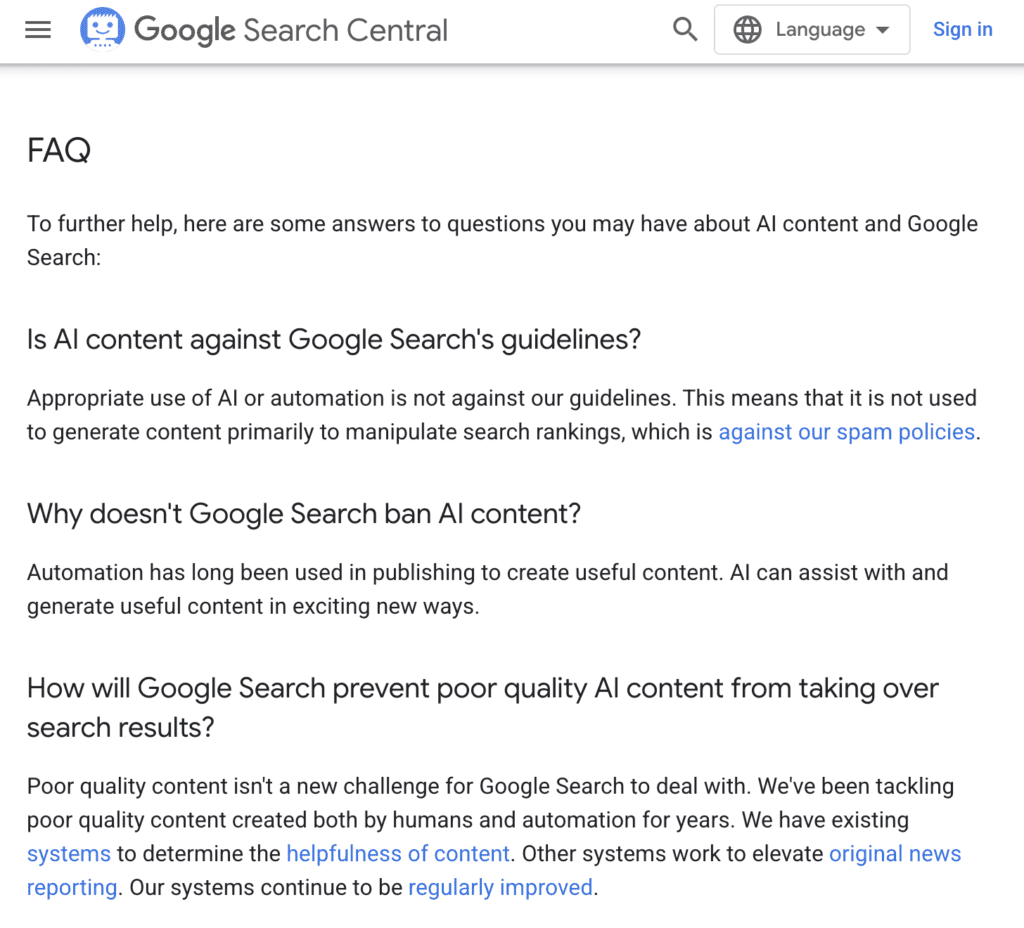
Does Google penalise AI-generated content?
However, Google is very clear that they reward high-quality content, and low-quality automated content is subject to their spam policies:
When it comes to automatically generated content, our guidance has been consistent for years. Using automation—including AI—to generate content with the primary purpose of manipulating ranking in search results is a violation of our spam policies.
AI detection tools
In January 2023 we heard about a tool called GPTZero for detecting AI content. Of course, we were intrigued by this, so we had a good play with the tool to test its capabilities.
Since then, a variety of other tools have come onto the scene, including one called “OPENAI DETECTOR” and another from OpenAI called “AI TEXT CLASSIFIER”, which they have now discontinued.
We decided to carry out Phase 3 of our “using AI for SEO” experiment and put these tools to the test using our two experiment articles.
To see the full results of our experiment using the above tools and the conclusion as to whether Google can detect ChatGPT, read below:
We don’t want to give everything away here but our opinion is that both articles passed the detection tests and were believed to be written by a human.
One of the tools deemed the articles to be “98% or more real”, the other “very unlikely to be very unlikely AI-generated” and only GTPZero mentioned “your text may include parts written by AI”, which came to around 14% of the total text for the longer article and 17% of the total text for the shorter one.
Out of curiosity, we also ran a 100% human-written article through GPTZero, a random example that we had published on April 28th 2022, long before we even knew about ChatGPT. Guess what? That was deemed to have “sentences likely to be written by AI”, 18% of the overall text, which is more than either of the AI articles.
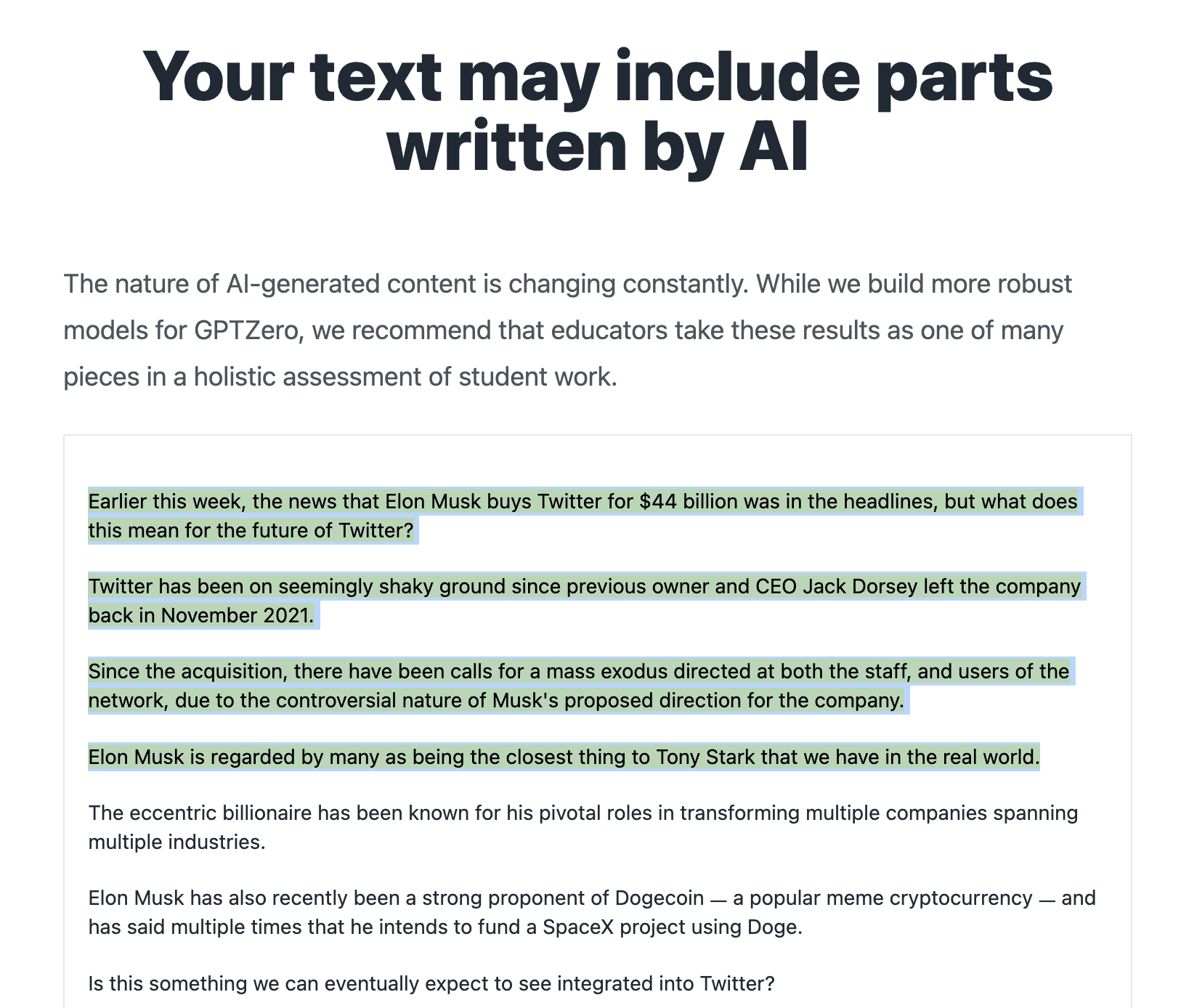
GPTZero incorrectly believes human content contains 17% text written by AI
Today, we use two tools for detecting AI-generated content, and we use these to help ensure our copywriters are producing the content by hand.
Having tested many different tools, we stuck with the following:
- Copyleaks AI Content Detector – https://copyleaks.com/ai-content-detector
- Originality AI Plagiarism Checker – https://originality.ai
Out of the two, Copyleaks is our preferred tool given its AI Insights transparency about why it’s flagged the content as AI-generated.
It’s been two years since we last tried the likes of GPTZero, so we wanted to revisit these two old AI-generated articles to see if they pass or get flagged as AI-generated today.
As can be seen below, the picture looks quite different, with both articles rated as 95 to 100% likely to be AI-generated.
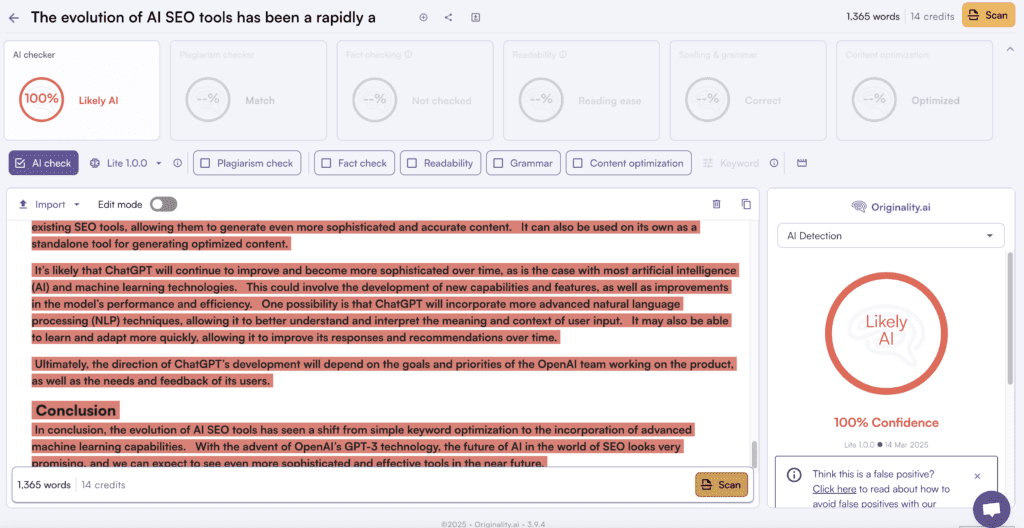
Originality AI detection test
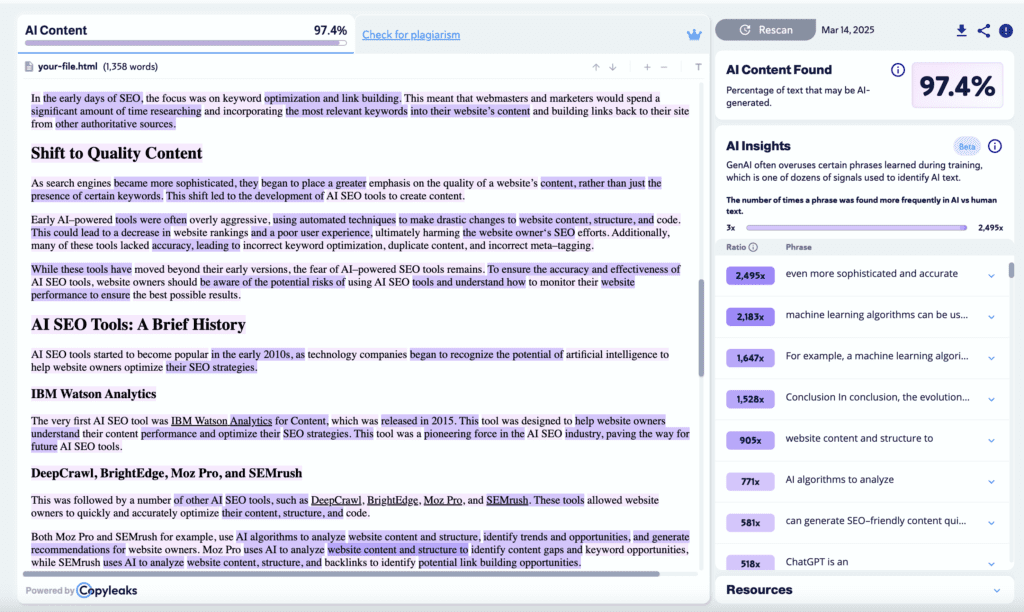
Copyleaks AI detection test
It seems fairly obvious that if tools like these can detect AI-generated content using patterns/insights, then Google can too.
Does it matter if Google views the content as being AI-generated?
This all comes down to your perspective and risk tolerance.
It’s safe to assume that Google can detect AI content and that the content will be either devalued or removed from its index if classed as spam.
If you are risk-averse, it’s also safe to assume that Google may one day start penalising pages or sites that publish low-quality automated AI content.
For those of us who have been doing SEO for a long time, we understand there is always a small element of risk, which is why it is so important to:
- Always keep up-to-date with Google’s guidelines, policies and documentation, like those we’ve put together here.
- Always strive to create high-quality, unique content that visitors will value, like this article, for example (and yes we have used ChatGPT for parts of this as well).
A final review – Do our test articles still rank three years later?
Given how much everything has evolved in the past three years, let’s see if the two GPT-3 articles created in 2022 still rank.
We know AI tools now view them as being almost entirely AI-generated, which is true, and we also assume Google takes the same view.
Well, Article 1 (“How OpenAI GPT-3 is Enhancing SEO for Text Generation”) still ranks very well. The search volumes are low but it ranks positions 1-3 in Google nevertheless.

ChatGPT SEO works (when done right)
We can’t find Article 2 (“The Evolution of AI SEO Tools with OpenAI GPT-3”) ranking for any keywords, but it’s still indexed in Google.
Final Thoughts – a review of the benefits of using ChatGPT for SEO
One of the most impressive outcomes of this experiment is the responses from those we asked to read the articles.
Everybody thought they were either written by a human. Nobody guessed that they were 100% AI-generated. That said, there were some minor points made:
Spellings – one person asked why the article was written using US spellings
Structure – the same person said the length of each section seems a bit rigid and could be varied more
It’s clear that both articles can be improved and would probably rank better with some human edits to the content and regular enhancements, but with the right input, direction and prompts, we now know that it is possible to create exceptional content written entirely by the AI.
So, now let’s go back to our original theories below:
- AI content that has been carefully directed by a human will be of better quality
- AI content that has been optimised with the knowledge and expertise of an SEO specialist will rank better
We feel we can confidently say that our first and second theories are correct. The first article wins on both fronts.
Even today, three years later, in 2025, the first article still ranks at the top of Google, whereas the second article is nowhere to be found.
Has our view changed? No. Using tools like ChatGPT for SEO, or even the new kids on the block like Gemini, Claude, and DeepSeek, are all absolute game changers for SEOs, content creators, coders, writers, academics, and even creatives.
In our articles below, we predict that this year or next, AI will take the next big leap to AGI (artificial general Intelligence).
Brilliance, Betrayal & Building Tomorrow: The History of OpenAI & Its Future (AGI) [UPDATED]
When AGI happens, we can expect even more radical uses of AI and tools like ChatGPT for SEO, with:
- Autonomous content strategies – AI systems could independently research, draft, optimise, and even publish SEO-friendly content.
- Hyper-personalised search results – AI-driven SEO could evolve to focus on real-time personalisation, adapting content dynamically based on user behaviour.
- AI-run backlink strategies – Future AI systems may identify and execute ethical link-building strategies without manual input.
- Seamless multimedia SEO – With AI’s increasing capability in video, image, and even voice search, SEO strategies will move beyond just text.
- Predictive analytics for rankings – AI could forecast search engine ranking changes before they happen, allowing for proactive content updates.
Using AI for SEO gives us an opportunity to adapt and improve the way we work, to become smarter and more efficient. It shouldn’t be seen as a threat but an opportunity.
Revisiting things in 2025 after undertaking our content refresh and AI detection experiments, we are even more convinced that the release of ChatGPT in 2022 is the modern-day equivalent to the inflection point created by the internet in 1983.
What do you think about ChatGPT SEO? We would really like to hear other people’s experiences and thoughts, so add your comments below. It’s not the end of this article, and we will be back to add more.


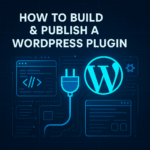


For years I have known that my reluctance to learn new coding languages has made me into a dinosaur.
Three days ago I gave a set of parameters for a mobile industrial robot that we are designing. It wrote the code in Python.
As you alluded to, knowing what to ask and how to ask it is going to be one of the most important skill sets in the future. You guys did a good job on this article.
Hi Joe, indeed, providing the right input/prompt makes all the difference. Thanks for the feedback, glad you liked the article.
The post on using AI for SEO with ChatGPT is a must-read for anyone looking to improve their search engine optimization. It provides a comprehensive guide on how to use the technology to boost website ranking and visibility.
Thanks Jessica, as each day passes, ChatGPT is finding more and more use cases. Using AI for SEO is definitely one area that’s going to keep growing, especially with the upcoming release of GPT-4.
Thanks For Telling.
No problem, just glad you found our ChatGPT SEO guide useful.